CALIFORNIA

INDEPENDENT CANNABIS JOURNALISM SINCE 2010 #31 | NOV. 2022THE ENLIGHTENED VOICE FREE / LEAFMAGAZINES.COM
THE HARVEST ISSUE CC #26 GROWING AT CANNA COUNTRY FARMS THE EMERALD TRIANGLE.



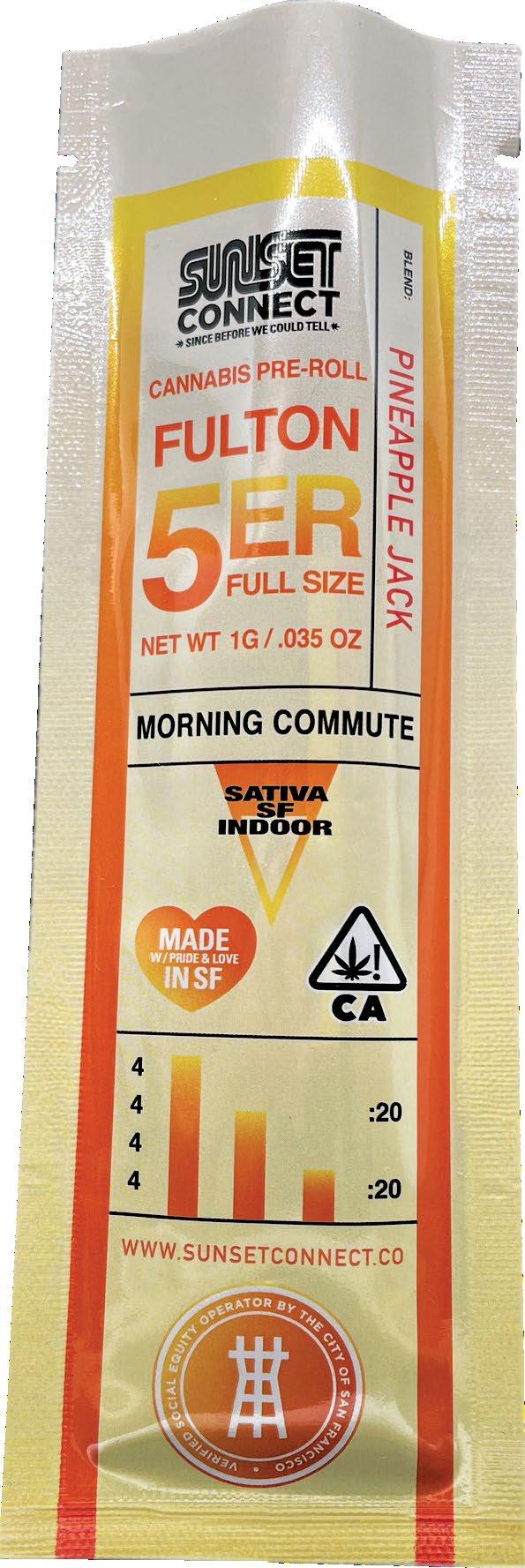
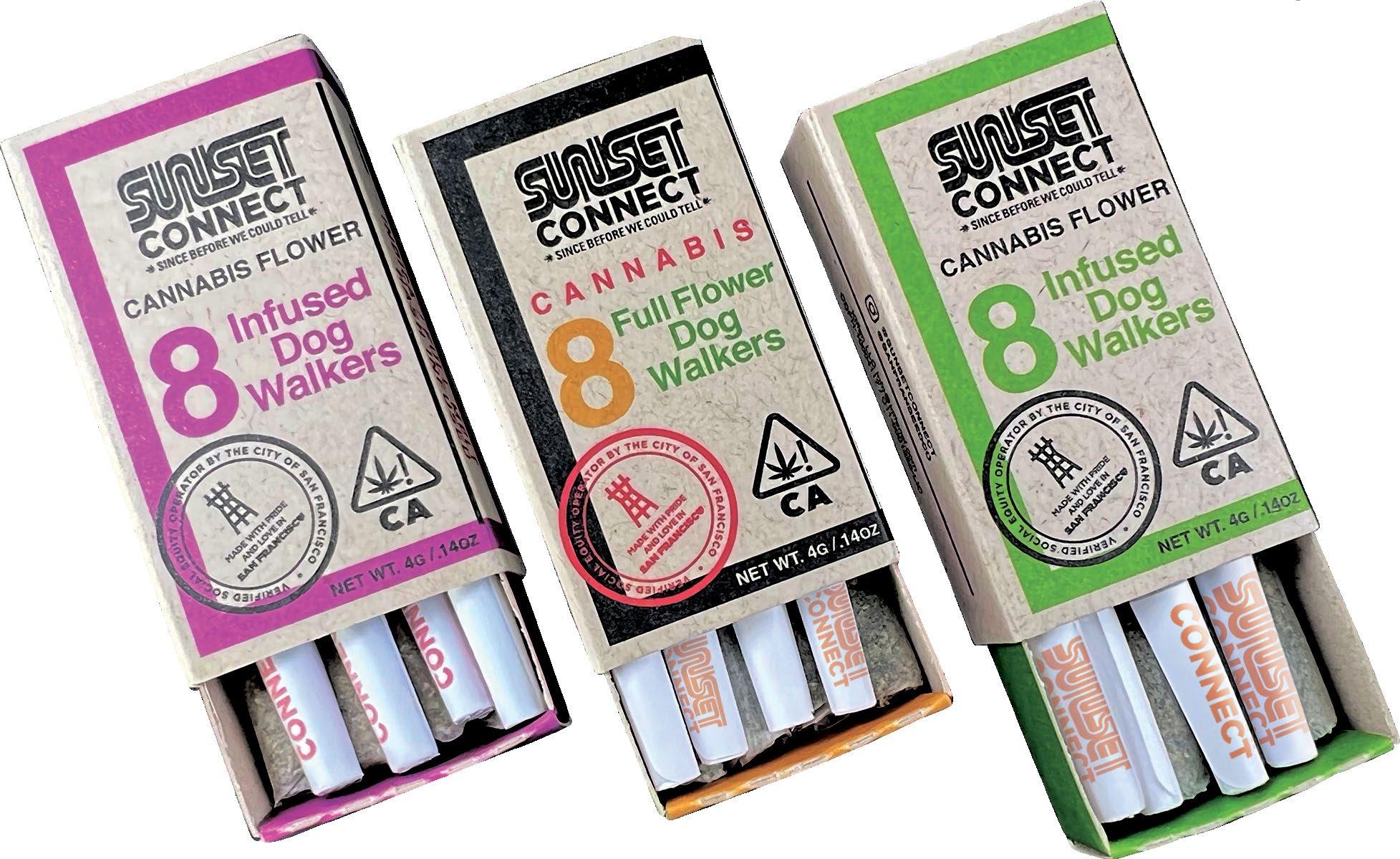
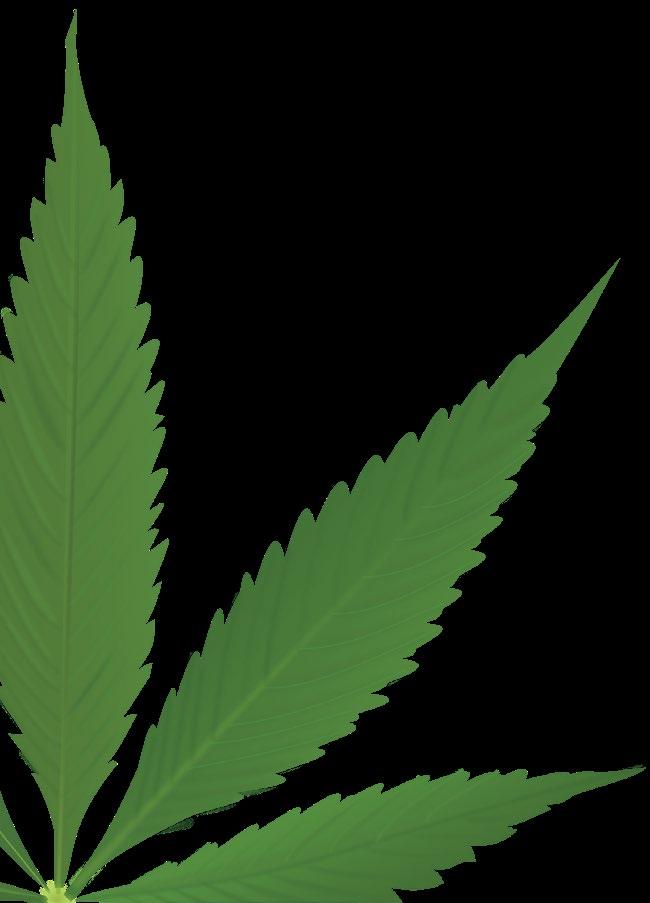




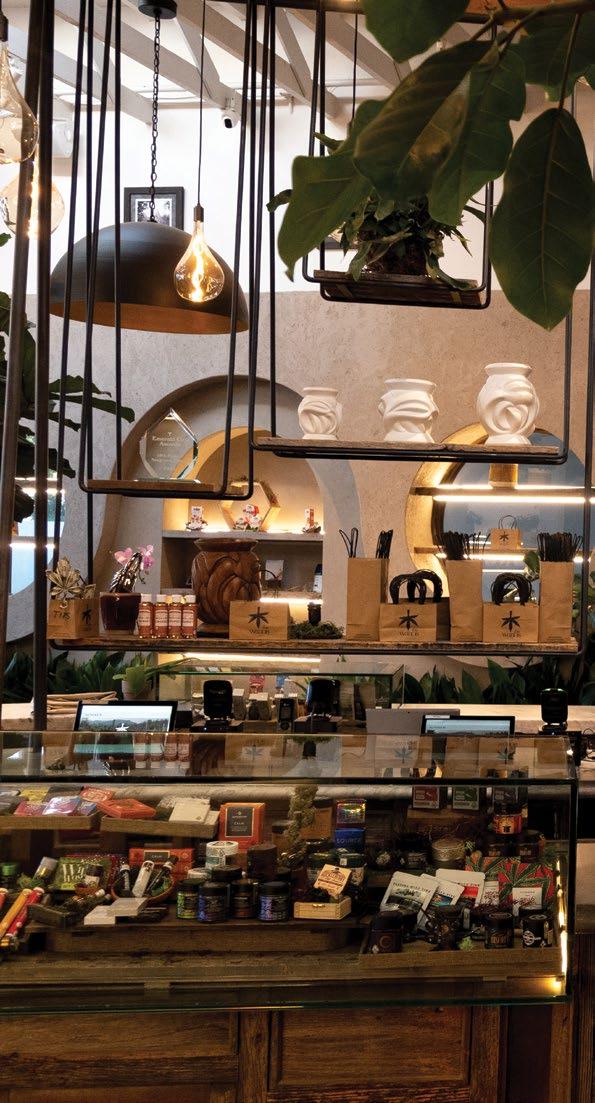
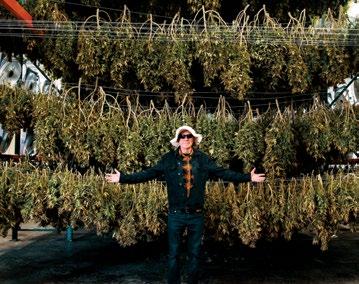
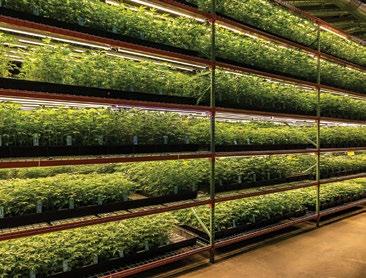
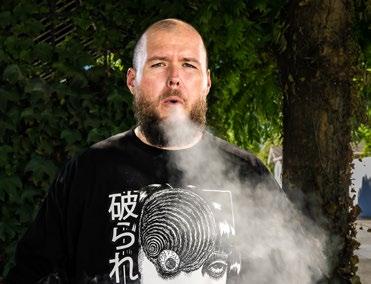
NOV. 2022 leafmagazines.com CALIFORNIA 4 NOV. 2022 [issue #31 THE harvest ISSUE 07 EDITOR’S NOTE 08 NATIONAL NEWS 12 SHOP REVIEW 14 STONER OWNER 16 CONCENTRATE OF THE MONTH 20 STRAIN OF THE MONTH 24 ESTRELLA RIVER FARMS 26 CANNA COUNTRY FARMS 28 HASH AND FLOWERS 30 EMERALD SPIRIT BOTANICALS 32 PHINEST CANNABIS PROFILE 36 CANNTHROPOLOGY 38 STONEY BALONEY 12 DAN WILSON @VISITHOLLLYWEED PHOTOS BY NATE WILLIAMS @NATEW415 & BOBBY BLACK @THEBOBBYBLACK420 MIKE ROSATI @ROSATIPHOTOS MIKE ROSATI @ROSATIPHOTOS 1432 PHINEST CANNABIS CALIFORNIA LEAF GETS AN UPCLOSE PEEK AT THIS CANNABIS TISSUE CULTURE LAB. STONER OWNER TED LIDIE THE ALIEN LABS FOUNDER TAKES HIS BRAND MAINSTREAM WHILE HOLDING ONTO HIS ROOTS. WORLD OF CANNABIS MUSEUM CANNTHROPOLOGY THE GURU OF GANJA ED ROSENTHAL 36 SHOP REVIEW The Woods WeHo ESTRELLA RIVER FARMS / P.24 CANNA COUNTRY FARMS / P.26 HASH AND FLOWERS / P.28 EMERALD SPIRIT BOTANICALS / P.30





All Things Cannabis For All People beardedlorax stashleylynn maaryjwhite rickerdj leaflifepodcastPODCAST THANKS TO OUR SPONSORS #192 THE ART OF TRIMMING #193 TRADITIONAL MEDICINE #194 THE HANGOVER SHOW WATCH ON LEAF LIFE PODCAST V2 LISTEN EVERYWHERE THIS MONTH: Marijuana products may be purchased or possessed only by persons 21 or older. This product has intoxicating effects and may be habit-forming. Marijuana can impair concentration, coordination and judgment. Do not operate a vehicle or machinery under the influence of this drug. There may be health risks associated with consumption of this product. For use only by adults 21 and older. Keep out of reach of children.


Each
Williams’
THE COVER
of the Humboldt
ridge-top orchard
at the Canna Country
the season of sungrown
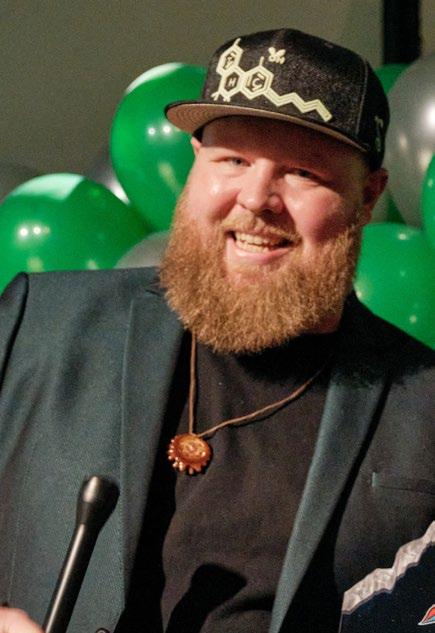
invite you to tour more grows from around the country and read our other editions of The Harvest Issue by visiting LeafMagazines.com and checking out our free online archive at Issuu.com/nwleaf.
 PHOTO by NATE WILLIAMS
@NATEW415
PHOTO by NATE WILLIAMS
@NATEW415
Editor’s Note



Thanks for picking up the Harvest Issue of the Leaf!
The harvest season is one of reflection and gratitude for the bounties provided by Mother Nature, and there’s no better crop to be dankful for than Cannabis.
A century of prohibition put Americans out of touch with Cannabis as a plant, relegating it to the “dangerous drugs” pamphlets – complete with a simple leaf translating to a symbol as feared as Mr. Yuck. It’s easy to be scared of an idea – like a symbol for a harmful drug – but it’s a lot harder to be in fear of a plant. Seeing ganja growing in the sun takes away the stigma, for there’s nothing more natural or beautiful than leaves and chunky colas dancing in the wind to an invisible beat.

Cannabis is an agricultural product, grown on farms – with the same salt of the earth, soulful types who would otherwise be growing corn or soy – if only those plants had terpenes. My favorite part of the Harvest Issue is sharing the pride and hard work it takes to grow plants from spring until fall. There are few experiences more magical than standing amongst head-high Cannabis plants glistening with THC crystals and filling the air with a pot-pourri of terpenes which serenade the senses.
No wonder one of the neighbors to Washington state’s Treehawk Farms is trying to get the county to “Stop the Stink” each harvest season. We can only hope somebody gets that person a joint…
I hope that you enjoy this issue of the Leaf, and invite you to visit leafmagazines.com to check out all of our amazing issues. From an outdoor crop in Fairbanks, Alaska to the rolling hills of green in Southern Oregon and Northern California, and stretching all the way to the Northeast where outdoor crops race to beat the first frost, we have wonderful photos and stories of the farmers and the plants we all love. It’s like a nature special you can smoke!
And please do support an outdoor farm by purchasing sungrown Cannabis this winter – you’ll be surprised how the natural environment creates a unique and potent high that is perfect for the holidaze.
7 leafMAGAZINES.com ESTABLISHED 2010 THE ENLIGHTENED VOICE
NORTHWEST LEAF / OREGON LEAF / ALASKA LEAF / MARYLAND LEAF / CALIFORNIA LEAF / NORTHEAST LEAF
Exclusive Cannabis Journalism CONNECT WITH CALIFORNI A LEAF Have a strain, product, or news tip that the California Leaf staff needs to know about? Email bobbyblack@LeafMagazines.com! CONTRIBUTORS We are creators of targeted, independent Cannabis journalism. Please email us to discuss advertising in the next issue of California Leaf Magazine. We do not sell stories or coverage. We can offer design services and guidance on promoting your company’s medicinal, recreational, commercial or industrial Cannabis business, product or event within our magazine and on our website, leafmagazines.com. Email nate@leafmagazines.com to start advertising with California Leaf! WES ABNEY CEO & FOUNDER wes@leafmagazines.com MIKE RICKER OPERATING PARTNER ricker@leafmagazines.com TOM BOWERS CHIEF OPERATING OFFICER tom@leafmagazines.com DANIEL BERMAN CREATIVE DIRECTOR daniel@leafmagazines.com BOBBY BLACK STATE CONTENT DIRECTOR bobbyblack@leafmagazines.com NATE WILLIAMS SALES OPS & DISTRIBUTION nate@leafmagazines.com (415) 717-6985 MEGHAN RIDLEY COPY EDITOR meghan@leafmagazines.com O’HARA SHIPE ONLINE EDITOR ohara@leafmagazines.com BOBBY BLACK, DESIGN + FEATURES JOSHUA BOULET, ILLUSTRATION JACKIE BRYANT, FEATURES TOM BOWERS, FEATURES MARY CARREON, FEATURES STEVE ELLIOTT, NATIONAL NEWS MATT JACKSON, FEATURES ALEXA JESSE, FEATURES SARA MILLS-GAINES, SALES JESSE RAMIREZ, DESIGN MIKE RICKER, FEATURES MEGHAN RIDLEY, EDITING MIKE ROSATI, PHOTOS ZACK RUSKIN, FEATURES DAN VINKOVETSKY, PHOTOS + FEATURES NATE WILLIAMS, FEATURES DAN WILSON, PHOTOS + FEATURES TAG #CALIFORNIALEAF AND SHARE PIX OF WHERE YOU’RE READING OR PICKING UP THE MAG! @NWLEAF | @CALIFORNIALEAFMAG | ISSUU.COM/NWLEAF READ PAST ISSUES IN OUR FREE ONLINE ARCHIVE
WES ABNEY -Wes Abney ABOUT
year, the arrival of Fall ushers in the terpene-rich aromas and happy hum of anticipation that are the hallmarks of the Cannabis harvest season. For this year’s Harvest Issue cover, we selected Nate
photo
fog enveloping a
ripe with cultivar #26
Farms. Find a feature on that farm and others in our homage to
bounty. We also
“MY FAVORITE PART OF THE HARVEST ISSUE IS SHARING THE PRIDE AND HARD WORK IT TAKES TO GROW PLANTS FROM SPRING UNTIL FALL.”
President Joe Biden in October pardoned all prior federal offenses of “simple possession” of marijuana. Biden also wants the government to look at rescheduling or descheduling weed.

Biden requested a review of how marijuana is scheduled under federal law from Attorney General Merrick Garland. The president also included Health and Human Services Secretary Xavier Becerra in that request.
“As I often said during my campaign for President, no one should be in jail just for using or possessing marijuana,” Biden wrote. “Sending people to prison for possessing marijuana has upended too many lives and incarcerated people for conduct that many states no longer prohibit.
“Criminal records for marijuana possession have also imposed needless barriers to employment, housing, and educational opportunities,” the President wrote. “And while white and Black and brown people use marijuana at similar rates, Black and brown people have been arrested, prosecuted, and convicted at disproportionate rates.”
MARIJUANA POURS
BUCKS INTO
HOUSE GOP OPPOSES LEGALIZATION
A MAJOR GOP HOUSE CAUCUS in October released a “Family Policy Agenda” opposing federal marijuana legalization. The agenda tries to link pot use to suicide and violence. But the strident Cannabis criticism is leading to pushback even within the group, as staff for two members of the caucus said the lawmakers disagree with the prohibitionist rhetoric.
The 156-member Republican Study Committee (RSC) unveiled the agenda. It details 10 ideological principles and more than 80 legislative recommendations as its agenda. The stated goal is “to guide conservatives’ work to restore the American family.”

The committee includes nearly three-quarters of House GOP members.
VERMONT STARTS
21 + MARIJUANA SALES
VERMONT DISPENSARIES began selling Cannabis for adult use on October 1. But only three shops were ready to do so on opening weekend, reports the Associated Press.
Flora Cannabis in Middlebury, Mountain Girl Cannabis in Rutland and CeresMed in Burlington all opened to adult-use customers. The state licensed a fourth business to sell adult-use weed, but that shop wasn’t ready to do so yet.
A total of about 50 retailers prequalified for licensing.
This comes about two years after legalization took effect without the governor’s signature. At that time, Vermont was the 11th state to legalize. But it was just the second state to legalize through the Legislature, rather than through popular vote.
HEALTH PANEL SAYS JAPAN SHOULD ALLOW MEDICAL CANNABIS
A HEALTH MINISTRY PANEL in October recommended Japan allow the importation and use of medical marijuana products.
The recommendation is based on medical needs, and to modernize Japan’s drug laws to conform with international standards, according to the committee. The panel wants to change the policy for Cannabis medicines when safety and effectiveness are confirmed.
Japan has harsh laws against non-medicinal use of marijuana. It should consider approving the import, manufacture and use of Cannabis medicines, subject to the same approval process as pharmaceuticals, the health ministry panel said.

MARIJUANA CULTURE IS QUICKLY BECOMING MAINSTREAM CULTURE
Americans broadly agree that the country’s marijuana laws need an update.
to polling conducted by Morning Consult/Politico just days before President Biden’s Oct. 6 marijuana pardons, 6 in 10 American voters said weed should be legal in the U.S.
That number rises to about 7 in 10 among voters under 45 (70 percent), Democrats (71 percent) and Black voters (72 percent). Even among the groups least likely to support legalizing marijuana – Republicans (47 percent) and voters 65 or over (45 percent) – almost half of respondents agreed. There’s no real divide across regions, either.
Public opinion has changed drastically on this issue in the past two decades. But getting skittish lawmakers to catch up with national savvy has not been easy when it comes to marijuana culture.
“Current laws ... do not reflect this sweeping bipartisan, universal support,” Five Thirty Eight reports. ”The legalization of marijuana puts a spotlight on the divide between Americans and politicians, namely Republican members of Congress.”
coAST
NEW YORK ALLOWS PATIENTS TO GROW
Starting in October, New York medical marijuana patients are legally able to grow their own Cannabis at home. Lawmakers approved the legislation in late September. Advocates say it allows more access to those who have chronic conditions or other ailments that qualify – especially low-income patients.
Patients can legally grow up to three mature female plants and three immature female plants. But the rules allow no more than 12 total plants per household.
“It is a big step forward for medical patients,” said Lyla Hunt. Hunt is the deputy director of public health for the New York State Office of Cannabis Management. ”We’ve seen real extreme interest from patients and designated caregivers to have the ability to cultivate Cannabis at home.”
STEVE ELLIOTT,
nov. 2022 leafmagazines.com 8 national news STORIES by
AUTHOR OF THE LITTLE BLACK BOOK OF MARIJUANA the white house
BIDEN PARDONS ALL FEDERAL SIMPLE POSSESSION CASES worth of medical marijuana was bought by Missouri patients during the first two years of legal medicinal sales. $494m of marijuana arrests in Virginia (where marijuana is legal for adult use) are of Black people, who make up 20% of the population. 19 states have legalized Cannabis for adult use. pounds of untaxed marijuana were seized by Oklahoma authorities in another October raid. 17k states have legalized medical marijuana. 38 pounds of untaxed marijuana were seized in one Oregon raid in October. 9k 60% he campaign to legalize adult-use marijuana in the Show-Me State is getting big bucks from the medical marijuana industry, reports the Missouri Independent. Legal Missouri 2022 – the political action committee supporting a Cannabis legalization proposal on the Nov. 8 ballot as Amendment 3 – has raised nearly $700,000 in large donations since Oct. 1. The money came from companies in the medical marijuana industry. Amendment 3 gives these firms first dibs on any lucrative adult-use retail licenses issued by the state to grow and sell Cannabis. T midwest MISSOURI MEDICAL
BIG
LEGALIZATION NORMALIZATION
According
eAST
THE NEWS IN BRIEF








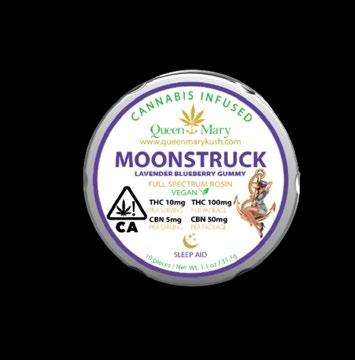


A FIXIN FOR A AVIXEN FIXIN FOR A VIXEN Daily Regimen (Easy as 1, 2, 3!) www.queenmarybrand.com www.queenmarybrand.com MOONSTRUCK GUMMY Pain Relief and Sleep Aid Vegan, Gluten Free, Fast Acting, Rosin BOOST THCV ELIXIR Energy, Motivation, Appetite Suppressant ENCHANTED GUMMY Focus and Mood Enhancer
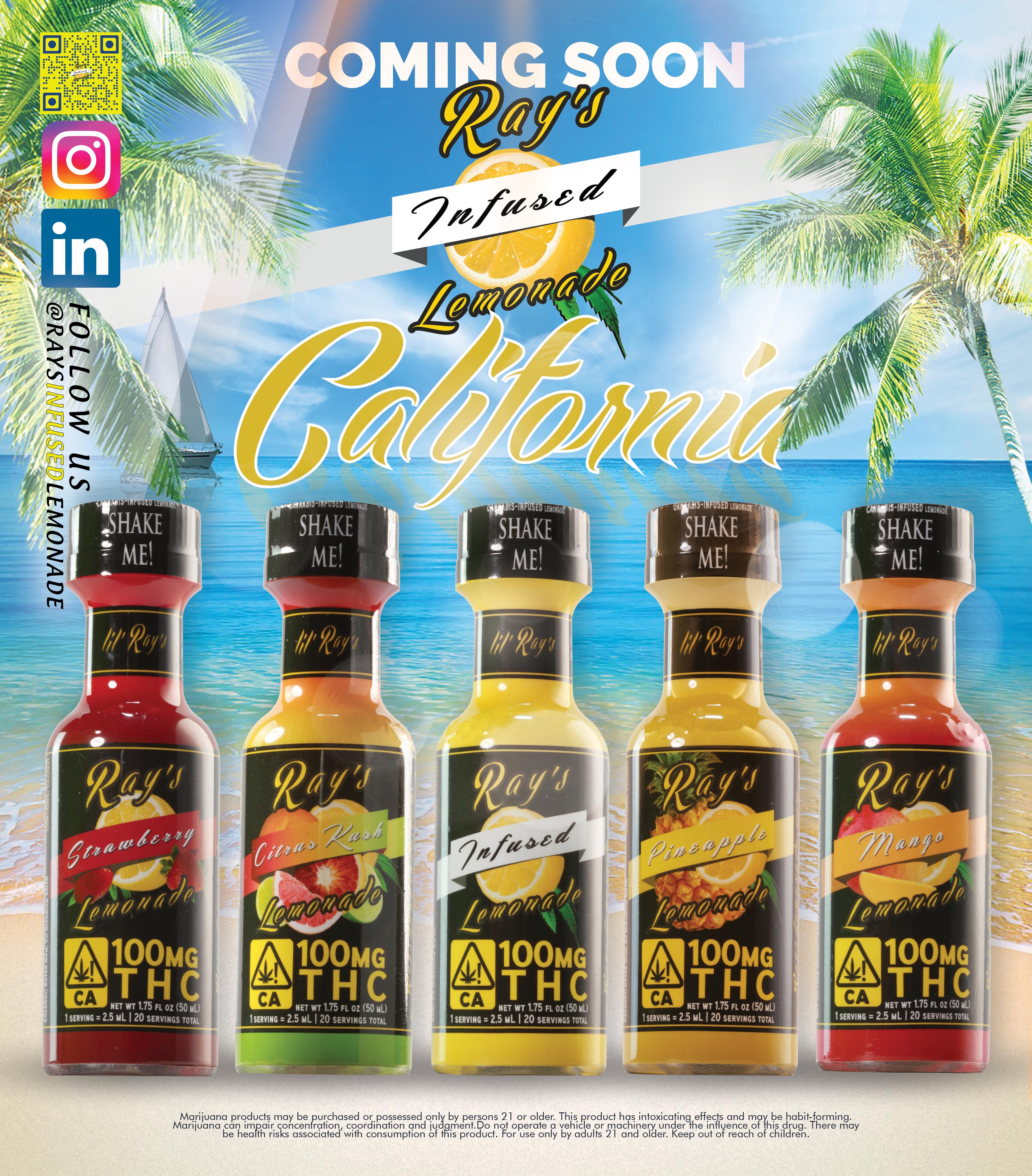



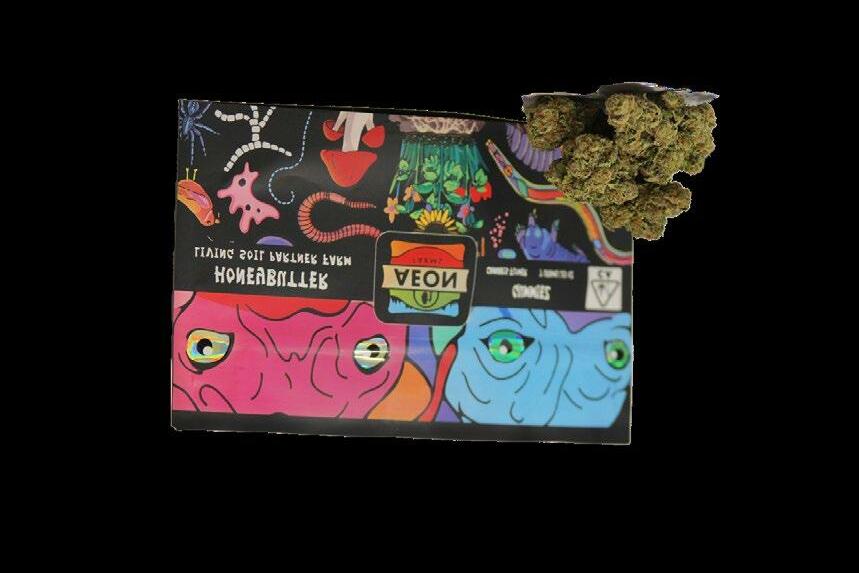

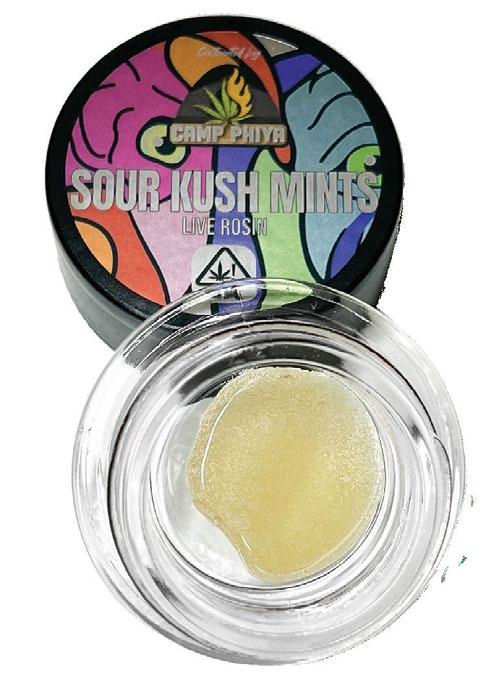

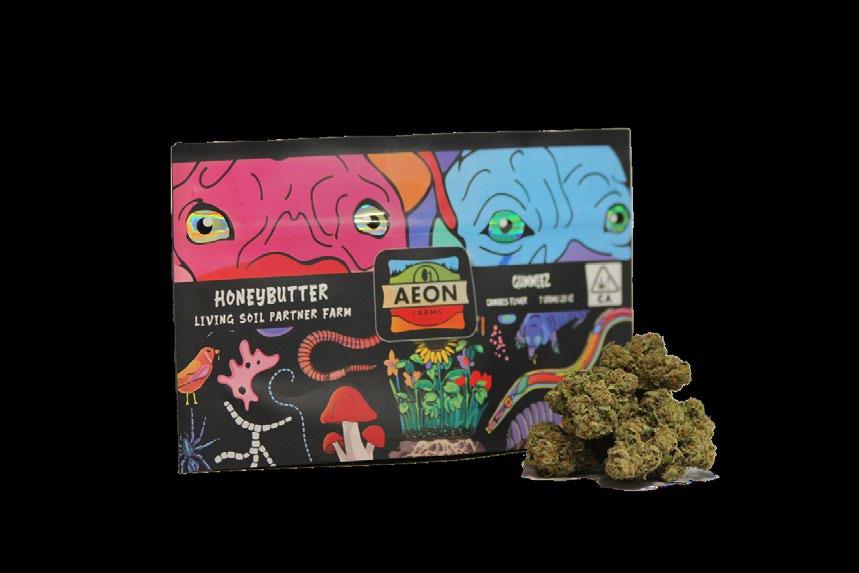
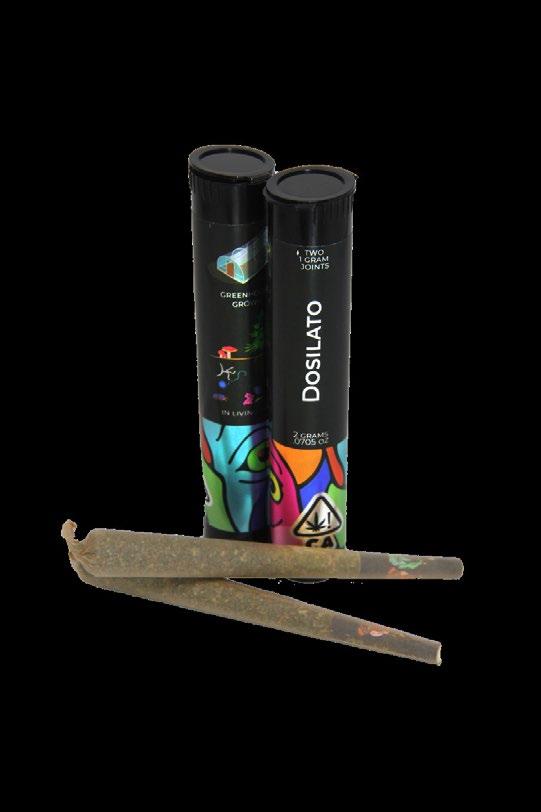


shop
THE
THE VISION
Launched in partnership with Harrelson’s wife Laura, comedian and talk show host Bill Maher, and their other partners Devon Wheeler, Jay Handal, Thomas Schoos and Michael Bernman, the dispensary aims to be an oasis among the shops and bars in West Hollywood. A longtime Cannabis activist with strong ties to the sungrown community of Northern California’s Emerald Triangle, Harrelson and his team wanted to provide a respite from the norm of the indoor-focused Los Angeles scene, and built every part of the concept with that in mind.




SET & SETTING
The space is open and airy, with tons of natural light, wooden accents, and 13-foot-tall fiddle leaf fig plants that give visitors a refreshing impression of being in a tropical garden. Informative displays showcase highlighted brands, with an emphasis on the farms of Humboldt and Mendocino counties. The flow of the main sales floor is inviting and natural, built around a counter that extends out into the middle of the room. It’s an excellent use of space and the different displays give shoppers something to do besides just stare up at a readerboard. It has a garden boutique feel that fits in nicely with the locale.
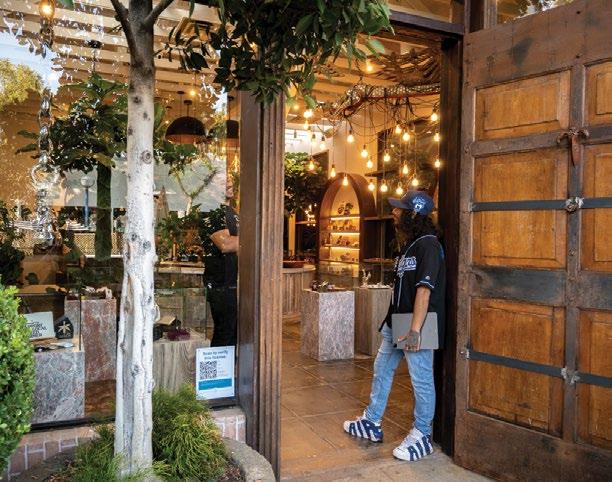
THE LINEUP
Product curation at The Woods focuses on premium, respected brands and spotlights full-term sungrown flower as its mainstay. It’s part of the mission of the shop to bring the passion and terpene-laden love of cultivation from Northern California to the glitz of Hollywood – featuring products from farmers who fought for decades to bring the plant to the people during the times of prohibition. You can find legacy sungrown brands such as Ridgeline Farms, Huckleberry Hill Farms and Swami Selects next to powerhouse indoor brands such as Alien Labs and Connected. Prices are competitive for the area, with eighths on the menu ranging from less than $20 to almost $80. The edibles selection is stacked, making up more than 25% of the total product mix. Expect to find an array of favorites from 710 Labs, Papa & Barkley, Space Gems, Kiva and more, alongside a tight but well-selected lineup of concentrates.
THE EXPERIENCE
The Woods WeHo offers delivery via its website, but why anyone would skip out on visiting this beautiful shop in-person is a mystery. Especially now, since Harrelson’s team opened the jewel of the property, an open-air consumption lounge, at the end of October. The lounge offers zen cabanas available for rent, and a dab and infused beverage bar. The staff in the bar will happily answer questions for revelers who want to learn more about terpenes, efficacy and the history of the plant. The open-air space in the lounge matches the vibe of the interior of the shop and enhances the tropical oasis feel. Whether you’re in the neighborhood or simply visiting Hollywood, The Woods WeHo dispensary and consumption lounge make for an experience you won’t want to miss.
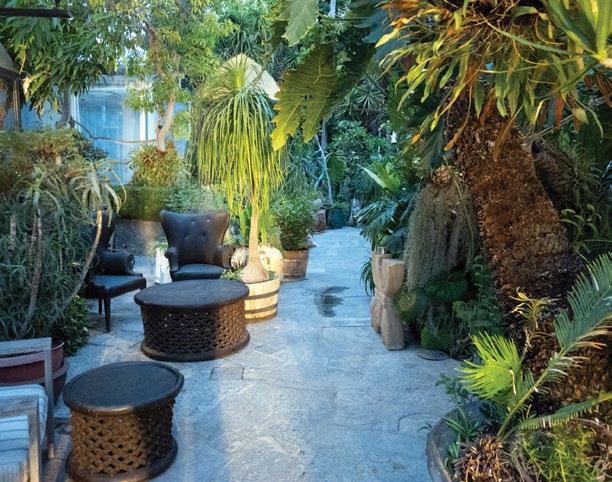
FOR YEARS, Woody Harrelson’s name has spelled success for Hollywood productions.
So it was no surprise that Harrelson’s dispensary, The Woods WeHo, opened to significant fanfare in West Hollywood earlier this year. Everyone expected it to garner attention. What was uncertain was whether it would be well-executed. After a few visits, it’s safe to say that this is one project that deserves the hype.


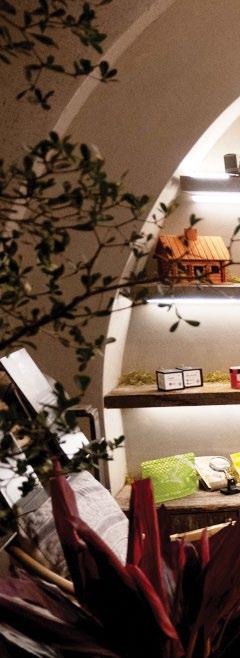

nov. 2022 leafmagazines.com 12
review
WOODS WEHOTHE WOODS WEHO
Partner
Devon Wheeler Inviting Exterior Open-air Consuming


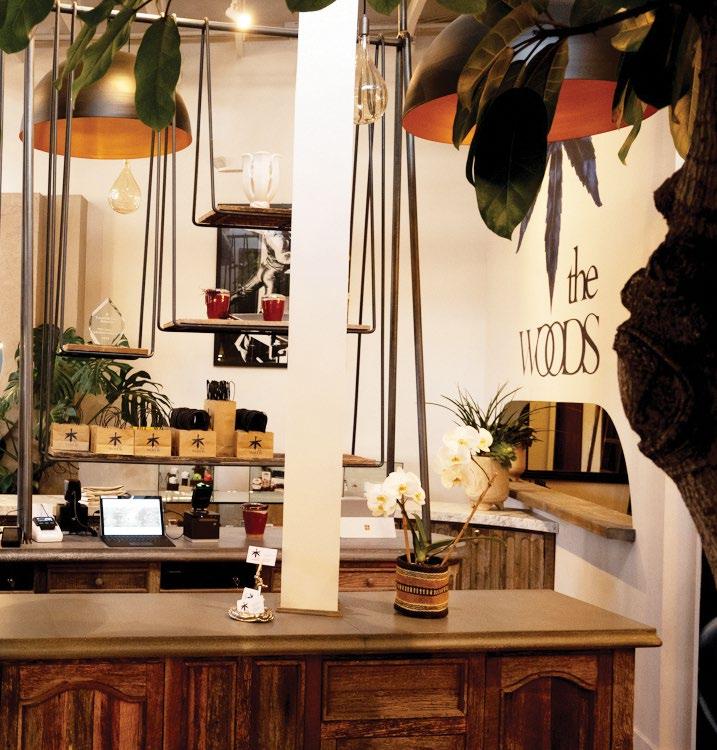
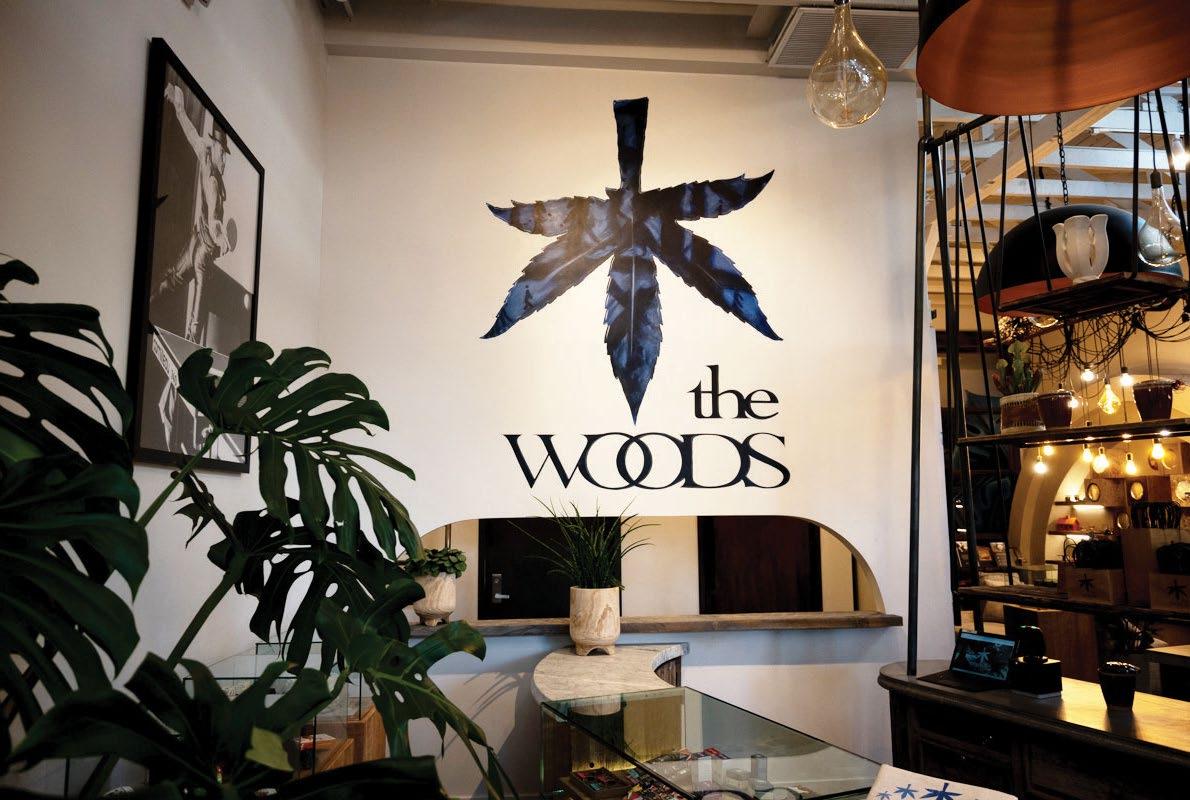
REVIEW by TOM BOWERS @CANNABOMBTOM/CALIFORNIA LEAF | PHOTOS by DAN
WILSON
@VISITHOLLYWEED THE WOODS WEHO 8271 Santa Monica Boulevard, West Hollywood, Calif. thewoodsweho.com @thewoodsweho 9 a.m. - 9:50 p.m. daily (844) 484-3966
TED LIDIE ALIEN
TED LIDIE IS A NERD, AND HE WANTS YOU TO KNOW IT.
The founder and head honcho of Alien Labs was raised on a steady diet of comic books, manga, B-movies and cartoons – a stylistic recipe that’s helped shape one of the most recognized brands in California, Arizona, and now Florida.
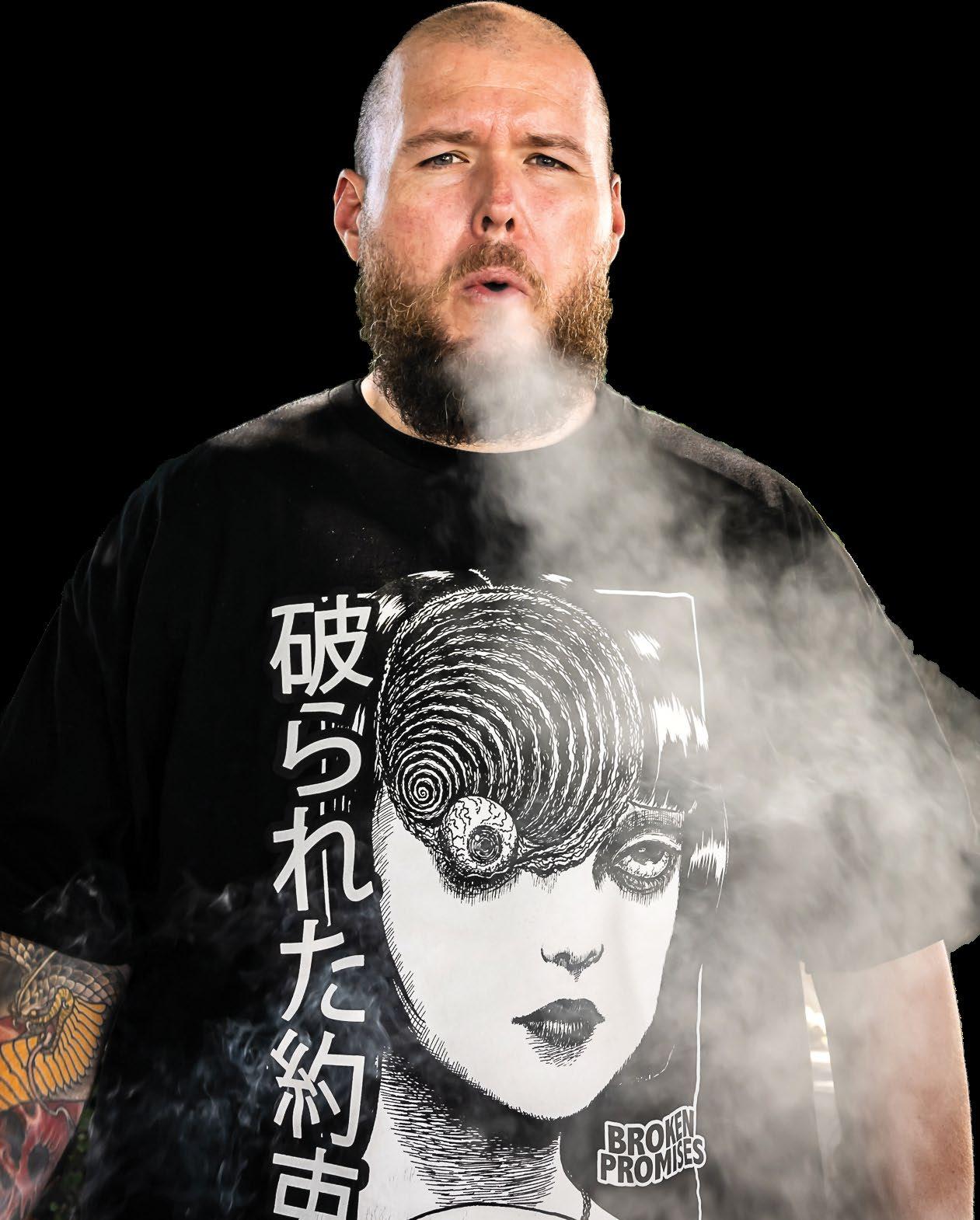
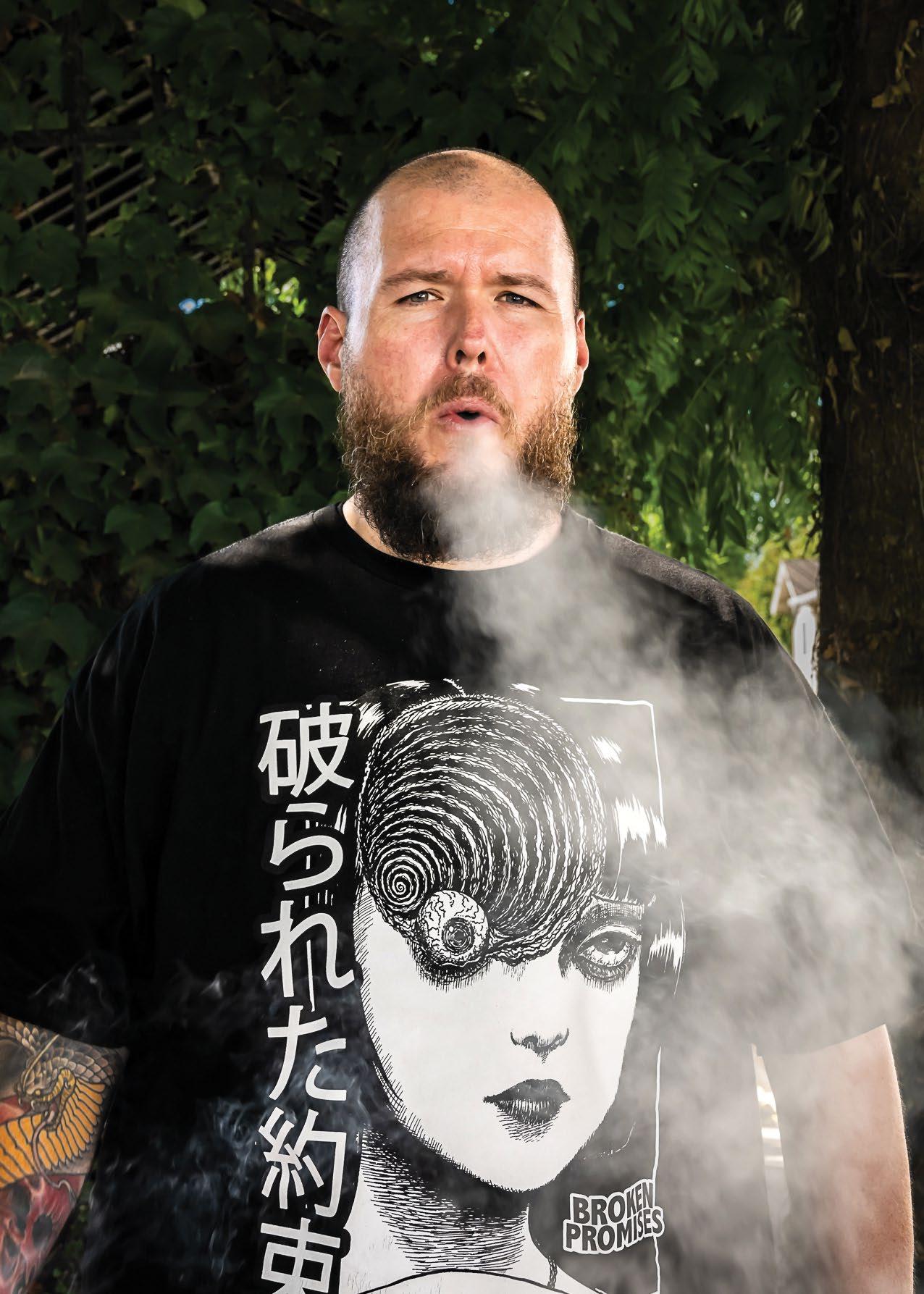
Lidie’s undeniable impact on the Cannabis market has helped skyrocket the company to the leading edge of recreational weed, all the while staying true to the counterculture that put him there – not just growing their brand as a retail company, but also as a commentator of pop culture (the way Alien Workshop, Spitfire or World Industries did in the ‘90s).
The stoner in the owner makes him conscious of the moves they make as a company, but he also understands that things have to change in order to evolve. That’s part of why Alien Labs just expanded into 180 Zumiez stores. But despite this new national arena, for the man at the helm, the mission is still the same as it was in the legacy days: seeking new frontiers, pushing boundaries, and staying true to the scene.
At Alien Labs’ HQ in Sacramento, we talked with Lidie about the importance of being a stoner in today’s Cannabis market and what role legacy MSOs play in keeping traditions alive.
A Stoner Owner is a Cannabis business owner who has a relationship with the plant. We want to buy and smoke Cannabis from companies that care about their products, employees and the plant. You wouldn’t buy food from a restaurant where the cooks don’t eat in the kitchen, so why buy corporate weed grown by a company only concerned with profits? Stoner Owner approval means a company cares, and we love weed grown with care. Let’s retake our culture and reshape a stigma by honoring those who grow, process and sell the best Cannabis possible.


14 leafmagazines.com STONER OWNER nov. 2022
What is it about smoking weed that got you passionate about the plant? I always liked how it made me interact with the world around me, and I’ve always wanted to bring that experience to more people. The world’s always been uptight, especially now more than ever. People gotta relax, and if there’s one thing weed does, it chills you out. So many people on this planet would benefit from taking a little hit off the J.
How much do you attribute being a stoner to the success of your brand? How can you expect to connect with your consumers on a deeper level if you don’t even use what you’re selling? You need to understand how something can make you feel or why somebody might like it. There’s a subjectivity to Cannabis, but there’s objectivity too. You can tell if something is good, even if it’s not your thing. I never liked the lemony terp in Melonade, but that didn’t stop us from putting it out because I knew people wanted it. You have to find out if it’s good and if other people will like it … that takes a stoner.

What kinds of things influenced you after you started smoking? Manga and comics for sure, but also movies like ‘Cheech & Chong,’ ‘Half Baked’ and especially ‘Tommy Boy.’ Plus, a lot of old skate brands from CCS. Those are some of the big inspirations we continue to draw from. People are always surprised to find out I’m a nerd, but really that’s what Alien Labs is about: It’s for the people that aren’t always represented in our culture – even stoner culture. Growing up, it wasn’t cool to talk about things like anime. Now, dropping collabs based on our favorite cartoons … it’s like getting to live out your dreams. It feels like the result of years of speaking those things into reality and expanding our tribe.
Is that a big part of what’s helped set Alien Labs apart in the Cannabis market? Definitely. As an owner, it’s all about having fun with your brand. Everything we do is about enriching the brand, while doing stuff that feels unique and natural. You’re always looking for ideas or collections about moments in time. Like the Heaven’s Gate capsule, think about what that was: A group of people who believed a spaceship hidden behind a comet was coming just for them. Tell me that isn’t some Alien Labs shit?
Do you feel that, as Cannabis goes national, Alien Labs and other legacy MSOs have a responsibility to act as stewards of stoner culture? For sure. With these larger arenas, it feels like we have one of the biggest voices in the room – and sometimes the only voice in the room that cares about the culture. A big part of our mission is staying true to who we are and maintaining authenticity with how we move. It’s so important to what Alien Labs is. The culture supports us, and we support the culture. That’s the reason we have success. That all goes back to wanting to be a part of the landscape. Growing up, looking up to skate brands like Hook-ups or Alien Workshop, seeing how they were focal points within the scene, showing things from our perspective. That’s the ethos of Alien Labs – take the stuff we’re into and present it to the people.
As Cannabis gains more of a national acceptance, how important is it to keep stoner traditions alive?

For me, I’ve seen what destroying the culture does. California is a good example. There’s a group of people trying to hold it together, but this shit has a lot of people jaded. If you go to a place like New York, where it’s alive and well, you can see that the industry hasn’t beaten them down. Everyone’s excited about what’s on the horizon. The culture is what keeps things exciting, not the industry.
What keeps you in this space? I can’t picture myself doing anything else. I love weed, I love getting people high, I love creating stuff, and I love building brands. To be able to do it on such a high level in multiple states, there’s nothing else I want to do. It’s also exciting to see where it’s going to go. That’s a big part of it. Most people are still trying to figure it out here in California. We’re in Arizona, now Florida, and figuring out more of the East Coast next. There’s no stopping this movement. I’d love to get to the point where Alien Labs shirts are in stores around the world.
Alien Labs has always had a reputation for next-level design. How important is it for you to have a large merch profile? I think it’s crucial today to be seen as a full brand with marketing, merchandise and product. Something like designing more than just a logo on a
shirt – that attention to detail makes people respect the brand much more. If you’re only known for one thing, like weed, and you have a bad season, you’re fucked. But if you’re known for being competitive in multiple fields like merch, concentrates and events, you might be OK. Being good at all aspects of your brand is pretty important. Lately, the main focus has been upping the quality of our Cannabis and our merch.
You also seem focused on improving fan interactions, sponsoring outdoor street fairs, and even creating a “happy meal” for the Y2K strain release. You know what was crazy about the year 2000? Beanie Babies. My best friend Scott and I had my mom drive us around to all the McDonalds to collect the different ones. When we dropped Y2K, I thought it would be sick to recreate that. I told my marketing team, then we linked with the burger trucks and designed the packaging and alien babies within a week. We don’t have a huge marketing budget, but most of it is on making stuff like that. The rest is for events that enrich our peers, things we don’t sell weed at – we just come to show up to have fun.
What do you envision for the future of Alien Labs?
I want my kids to be involved someday. If anyone asks my daughter what she wants to do, she always says, “I want to go to work with my dad.” That would be sick to me, to get to raise a woman in weed and usher in that next generation. The chance to set my kids up, that’s what this is about. It’s for the love of the plant, but anyone who says they aren’t doing this for the bigger picture is kidding themselves.
I come from a poor family, and Cannabis – this whole scene –it’s given me a chance to make sure my family doesn’t have to worry like my mom and I did. Rocking a Rolex or driving a Ferrari, that’s not why I’m doing this.
You started smoking back in 7th grade. Do you think young Ted would believe where you are now? No way. We used to steal copies of High Times and think this shit would never be legal. Now here it is, and we’re at the forefront of the industry, on the pages of the magazines we grew up reading. It’s like living out a dream.
The scene may have changed, but for this man, it’s the same old Nikes and black t-shirts. That kid smoking weed and reading comics turned into the guy growing pot and collecting toys, who’s now choosing the next big strains before taking his kids to see Dragonball. If that isn’t a story of the rise of a weed nerd, I don’t know what is.

STORY by MATT JACKSON @ACTIONMATTJACKSON for CALIFORNIA LEAF | PHOTOS by MIKE ROSATI @ROSATIPHOTOS ALIENLABSSHOP.COM | @ALIENLABS
“We used to steal copies of High Times and think this shit would never be legal. Now here it is, and we’re at the forefront of the industry, on the pages of the magazines we grew up reading. It’s like living out a dream. “
PANCAKES LIVE ROSIN

Mountain Man Melts is new to California’s adult-use market, but by no means new to their craft.
Powered by Trinity County’s Gaia Gardens, Mountain Man Melts uses sun and soil grown Cannabis to create some of the most potent and flavorful rosin we’ve ever come across. As a hash-fo cused farm, Gaia Gardens continues to hunt out some of the best genetics available that lend themselves to quality rosin.
Pancakes is yet another winning cultivar to come out of the Cookies camp, this one bred in collaboration with Seed Junky Ge netics. The hybrid crosses Seed Junky’s wildly popular Kush Mints with Cookies’ ultra-hyped London Pound Cake, delivering a deli ciously complex profile that really shines in the form of live rosin.
The jar is bursting with terps, even right out of the fridge. The intense aroma is all over the map, constantly switching from sour lemon rind to doughy sponge cake to sweet wet earth to a mild greasy-oily-fuel profile. The rosin itself is cold cured, with a wet
cake icing consistency that is easy to manipulate. It boasts a notable glisten thanks to a thin sheen of terpenes that begin to sweat out anywhere near room temp.

A low-temp dab delivers a moderately expansive, full-flavored vapor that translates every nuanced el ement found on the nose beautifully and accurately to the palate. The effects are swift and certainly lean towards the couchlocked end of the spectrum. To say this one is heavy-handed would be an under statement – lightweights be warned, fun name aside, Pancakes has some serious kick to it.
This Pancakes live rosin is part of Mountain Man Melts first drop on California’s rec market. It’s exciting to see a brand launching with such high quality product, as it speaks to their intentions in the industry. If you’re a concentrates enthusiast, don’t sleep on trying some flavors from this outfit.
nov. 2022 leafmagazines.com REVIEW by NATE WILLIAMS @NATEW415 / CALIFORNIA LEAF | PHOTO by TOM BOWERS @CANNABOMBTOM concentrate of the month @MOUNTAINMAN.MELTS 72.35% THC / .53% CBD 16
LONDON POUND CAKE X KUSH MINTS
BRED BY COOKIES IN COLLABORATION WITH SEED JUNKY GENETICS
MOUNTAIN MAN MELTS


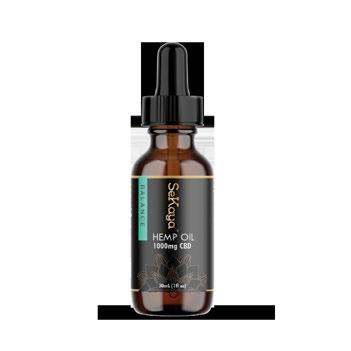


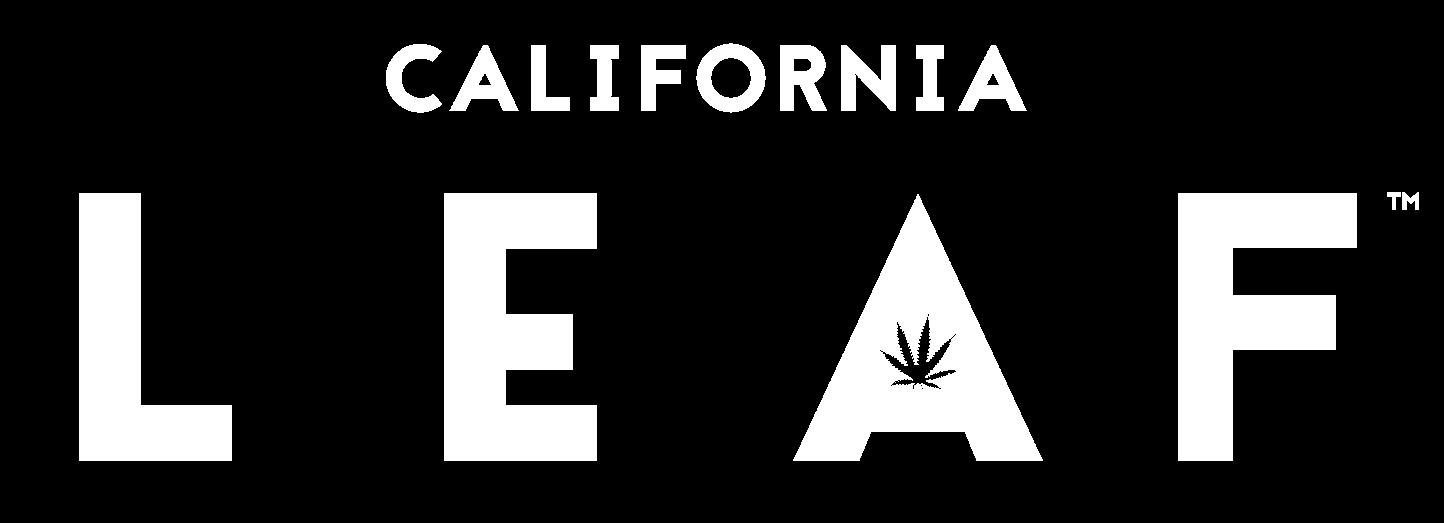



LEAFMAGAZINES . COM ADVERTISE IN THE EDIBLES ISSUE! LIMITED SPACE STILL AVAILABLE EMAIL SARA@LEAFMAGAZINES.COM TO GET YOUR AD IN THE DECEMBER 2022 EDIBLES ISSUE OF THE LEAF! CALIFORNIALEAFMAG CALIFORNIA LEAF MAGAZINE #CALIFORNIALEAF

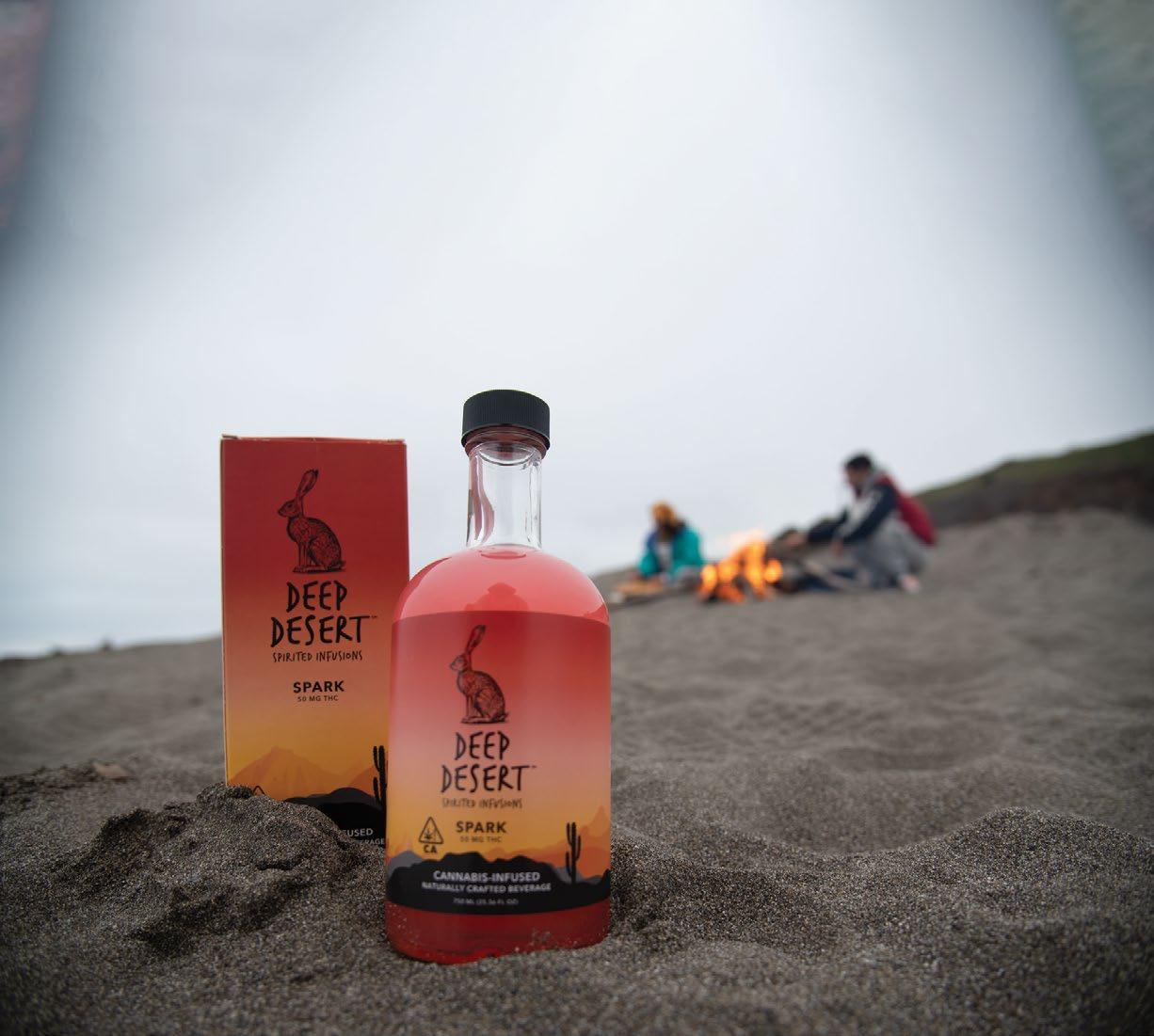

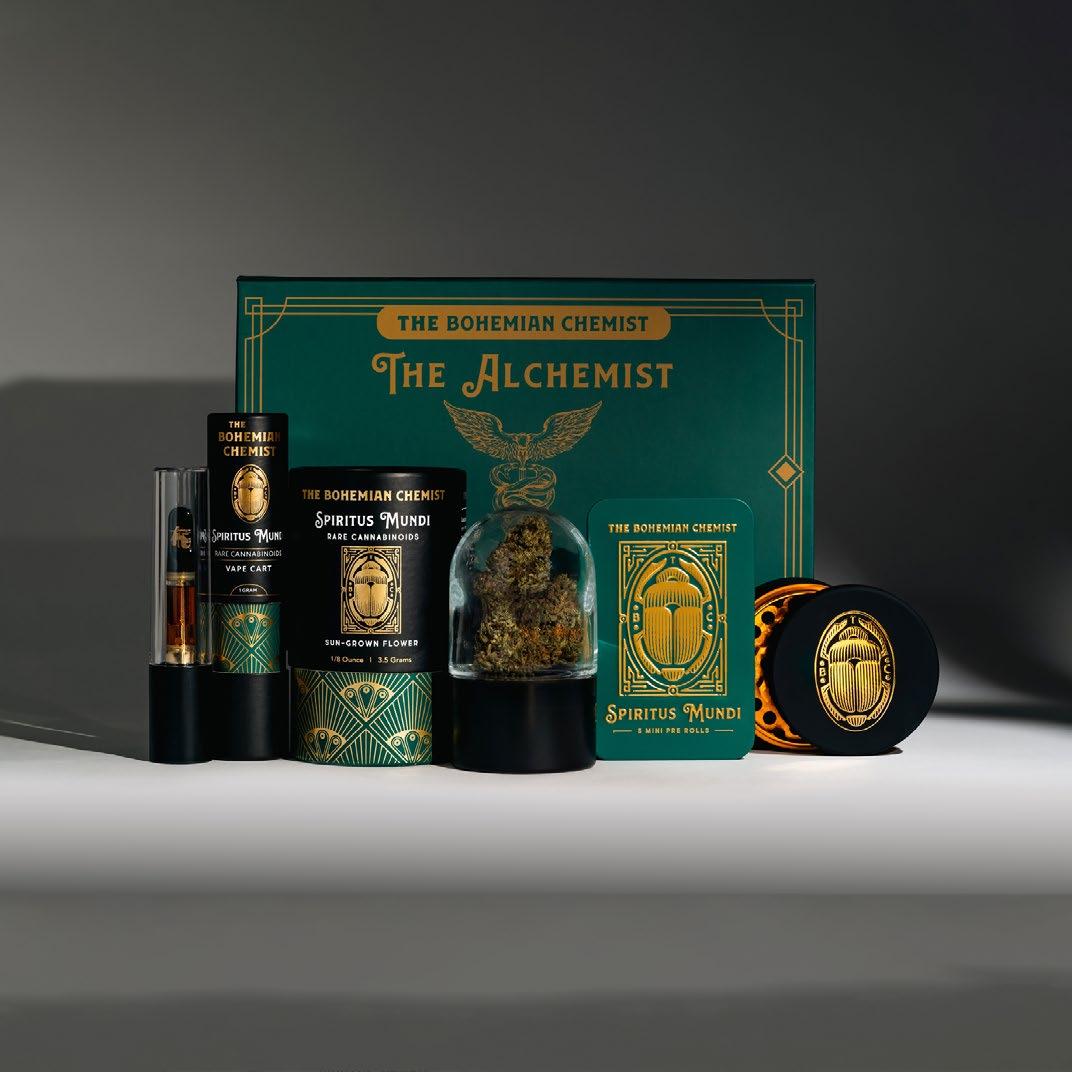
NATURAL SPRING WATER BOTANICAL EXTRA�TS LOTUS FLOWER ES�ENCE FAST-A�TING N0 SUGAR CALORIES HANGOVER SPIRITED INFUSIONS LIC# CDPH-100004289 / C11-0001230 LIC MUST BE 21+ TO PURCHASEDrinkDeepDesert.com


One of the things we all love about Cannabis, whether we realize it or not, is its unbelievable variety of expression. How one singular plant species can smell like grapefruit, diesel fuel, lavender, blue cheese, overripe mangoes, peppercorns, you name it – it’s truly magnificent.
IT CAN BE dark green with white hairs, light green with dark red hairs, or in the case of the famed #26 from Canna Country Farms – it can be so deep purple that it’s almost black, with a beautifully contrasting bright aroma of citrus, flower blossoms and candy.

The #26 is the perfect example of why the dual concepts of genetic diversity and terroir matter in the Can nabis cultivation community. Reggie Weedman bred the #26 with Ted Blair, owner of Canna Country, specifically because its genetic makeup would do well in the temperate, forested coastal climate of Southern Humboldt.
In a world where high THC num bers seem to dominate the spending patterns of people who don’t yet understand the way the cannabi noids, terpenoids and flavonoids of the Cannabis plant interact to create a memorable experience, we at Leaf Magazines bask in the beauty of a

flower like the #26. Bred from the mating of a Forbidden Fruit mother with Cherimoya – a cross of Kriz with Black Kriz, named for its aromatic sim ilarity to a Cherimoya blossom – the #26 hits you with a wonderful wallop of aromas that entice your senses the moment you open a jar. Once you’re over the shockingly exotic physical ity of the blossoms, you’ll enjoy the energetic yet balanced effects that come from the smooth, mouthwater ing smoke.
This is the type of expression that needs to be protected and savored. It’s a true connoisseur’s flower.
Canna Country ensures the longev ity of each of its sungrown harvests by preserving each branch and kola whole, encased in sugar leaves, only trimming to order in 10-pound batches. On our recent visit, we had the chance to hand-trim and sample flower from the 2021
harvest, and it was as bright, crystal-laden and flavorful as it was last winter. Like Dr. Strange says, “forget everything you think you know” about Cannabis.
Read our profile of Ted Blair and his farm on page 26-27 to find out more about how expertise and passion are driving the genetics conversation forward into a future that expands de liciously beyond the numbers-chasing, THC-obsessed landscape we currently inhabit. And keep your eyes out for a fresh batch of sungrown #26, hitting the market this month.
COUNTRY FARMS
REVIEW & PHOTO by TOM BOWERS @CANNABOMBTOM/CALIFORNIA LEAF HAVE A LEAD ON SOME SERIOUS FIRE? EMAIL BOBBYBLACK@LEAFMAGAZINES.COM #26 @CANNACOUNTRYFARMS CANNA
BRED &
CULTIVATED BY
v
“A wonderful wallop of aromas that entice your senses the moment you open a jar.”
15% THC 16.5% TOTAL
CANNABINOIDS

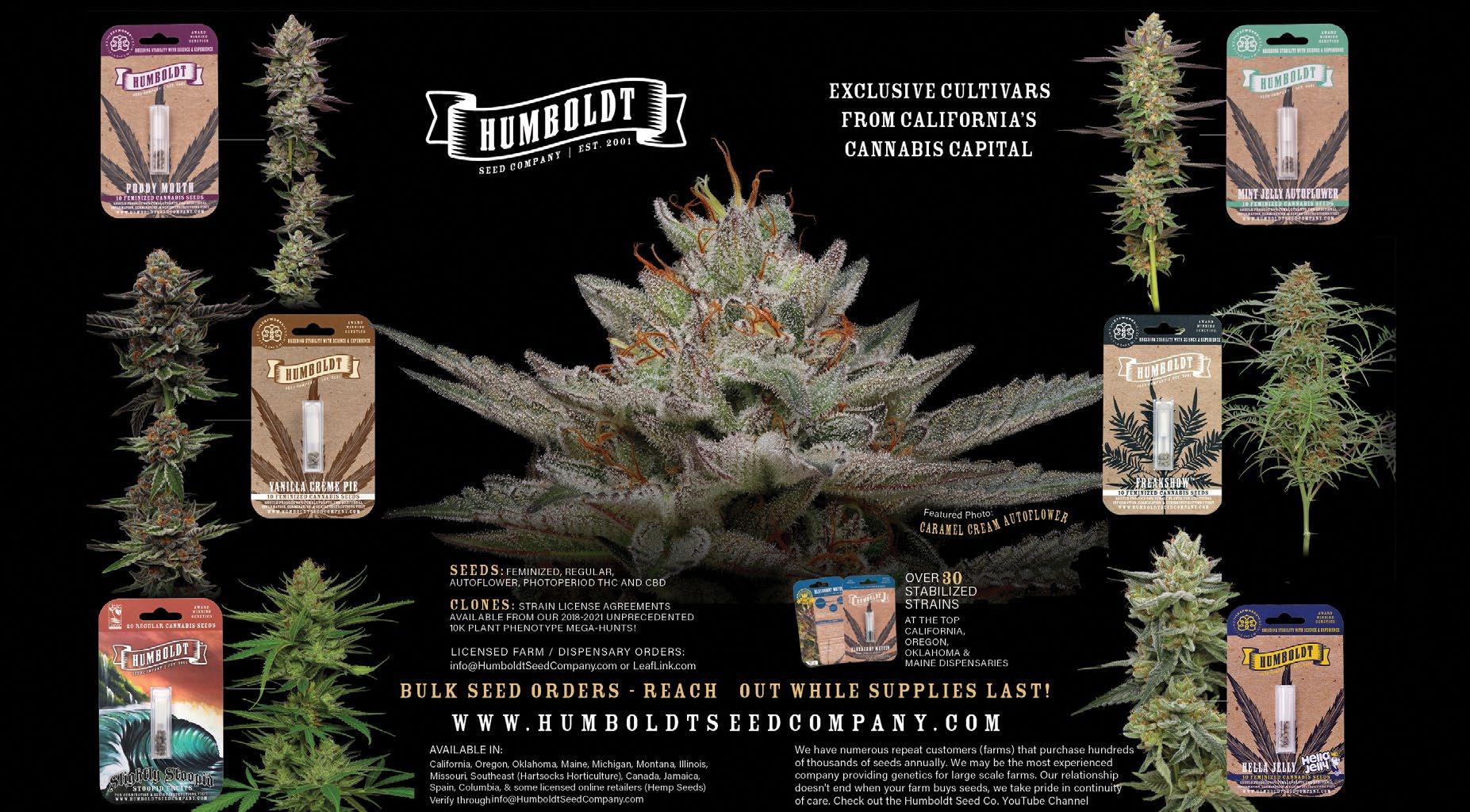

estrella river farms
TUCKED AMIDST the rolling green hills of Paso Robles wine country lies Estrella River Farms – a sustainable, sun grown Cannabis farm that bills itself as “the world’s first estate-grown weedery.”

“When I’m sitting at the bar in down town Paso, and I hear somebody next to me talking about the wine industry, I just replace the word ‘wine’ with ‘weed’ in my mind, and it’s the exact same sto ry,” says Estrella River Farms’ Bill Hod son. “That’s how we coined the phrase ‘estate-grown weedery’ – because it’s
the winery model, only with weed.”
Hodson purchased the 80-acre plot of land known as Estrella Ranch through his Cannabis real estate/marketing company Livewire Ergogenics (an affiliate of Estrella) about four years ago. It’s a pastoral piece of property just off the 46 East surrounded by empty, peaceful meadows – making it an ideal location for an outdoor Cannabis grow.
“There are no grapes near us, no neighbors to give us a hard time, so it
works out perfect,” Hodson explains.
“This is still primarily a cattle ranch; we still have livestock … we just happen to grow Cannabis on it as well.”

The property is bisected by Estrella Road into two 40-acre parcels. The western half contains the operational part of the ranch – inside of which a section has been partitioned off for the garden – as well as several barns and buildings, including a kitchen, rec room and living quarters for the workers (most of whom live on site).

24 leafmagazines.com THE harvest ISSUE nov. 2022
WILLIAM RANDOLPH HEARST IS SPINNING IN HIS GRAVE. In the early 20th century, Hearst’s media empire was the leading proponent of the “reefer madness” propaganda that eventually led to marijuana’s prohibition. But a century later, the ranch that his beloved grandson (and Hearst Corporation successor) George once called home is now being used to grow the “evil weed.” Talk about poetic justice.
CREW & COMPLIANCE
The core staff consists of five guys: there’s Jim Palm, Hearst’s old property manager who’s stayed on; Hodson’s son Blake, who’s learning the business; head growers Fritz and Nuusila Suani, two brothers who learned to grow weed from their father back in their homeland of Samoa; and Hawaii native Jason Spain, who calls himself “the janitor,” but seems more like a supervisor. Spain – who’d previous ly run grow operations in Oregon, Washington and Colorado – was brought into the project through one of Hodson’s partners.
“Jason came up here right after we bought it,” Hodson recalls. “He just looked around and said, ‘I could probably grow some of the best weed in the world right here.’”



LOCATION Paso Robles, California
CANOPY SIZE 130,000 square feet
PLANT COUNT 7,000
TEAM 5
KNOWN FOR Grapes and Cream Amarillo Kush Crasher PB Soufflé
QUICK HIT Estrella River Farms is adopting a vineyard approach as it expands its cultivation facilities with the intention to one day offer tours and tasting room samples.

Surprisingly, although Northern San Luis Obispo County has been notori ously conservative and anti-Cannabis, Spain says they’ve had little trouble getting local officials on board.

“We started the process three years ago, and from when we filed to when we got our permit, took us just 16 months,” he boasts. “So we’re the fastest on record.” Spain attributes this expediency to one thing: complete compliance, no matter the cost or inconvenience. “Whatever they asked us to do, we just did it,” he says. “We’ve spent hundreds of thousands of dollars … but if it makes sense for the environ ment and the safety of our employees, we’ll absolutely do it.”
THE GARDEN
The one-acre Cannabis garden oc cupies 130,000 square feet of outdoor canopy that includes 30 hoop houses containing around 6,000 plants, and another 1,000 plants in a separate 10,000-square-foot test garden. All of their plants are grown in fabric pots using their proprietary organic living soil blend which includes bat guano, feather meal, and Paso’s own Black Diamond VermiCompost.
They’re currently growing 17 different strains (including Grapes and Cream, Amarillo, Kush Crasher, PB Soufflé, and some old-school garlicky GMO), the majority of which were acquired as clones from Refined Genetics out of Salinas. This is only their second harvest here, but Spain says it’s already “light years ahead of last year’s crop.” After harvest, all of their flower will be white-labeled to Phire Labs and two other big brands (undisclosed) to be turned into con centrates and pre-rolls.
Building on their goodwill with the local government, Spain and Hodson have plans for some major expan sions in the works. In the next few years, they plan to add three more acres of outdoor garden and convert one of the barns into a 17,500-squarefoot mixed-light grow – using 1,000 custom-designed 15-watt quantum dot LED lights –which they claim can replicate the sun at 98%.
WINERY OF WEED
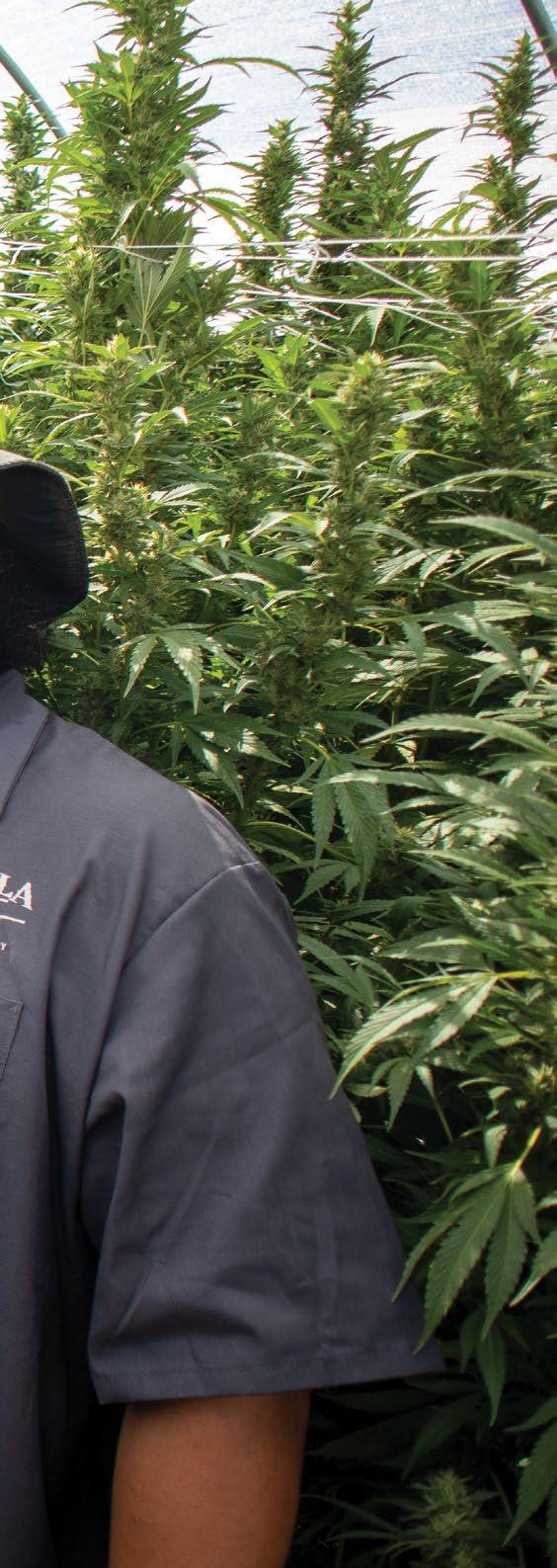
In addition to the farm, Hodson also hopes to make Estrella Ranch a Cannabis tourism destination. Though no Cannabis consumption or sales are permitted on the farm, those rules don’t apply to the eastern parcel. Just across the road from the farm is George Hearst’s historic home (complete with four fireplaces and a huge outdoor pool), which Hodson plans to rent out for guest stays and small events, as well as an old saloon building that will eventu ally serve as Estrella’s tasting room – making good on the company’s “winery model” slogan.
“Just like a vineyard, people will be able to drive up here, meet the crew, talk about the strains, then sample them in our tasting room,” says Hodson. “It’s all going that way … maybe not tomorrow, maybe not next year, but a few years from now for sure.”

STORY & PHOTOS by BOBBY BLACK @BOBBYBLACK420/CALIFORNIA LEAF
In addition to the farm, Hodson also hopes to make Estrella Ranch a Cannabis tourism destination.
ESTRELLARIVERFARMS.COM @ESTATEWEEDERY
THE “JANITOR” JASON SPAIN
THE PEACEFUL, PICTURESQUE PASTURES OF ESTRELLA RANCH.
COMING SOON: THE SALOON TASTING ROOM
BUSIEST SEASON
HEAD GROWERS AND BROTHERS FRITZ AND NUUSILA SUANI
THE ESTRELLA RIVER FARMS CREW, LEFT TO RIGHT: NUUSILA, BLAKE, JIM, AND FRITZ.
canna country farms
WE WERE WINDING through the hills of Humboldt while on the phone with Ted Blair, just about ready to send up a flare. The GPS kept trying to send us down roads that weren’t there. We were on the way to Blair’s grow, Canna Country Farms, and as is often the case with those storied SoHum roads, the Google robots weren’t quite sure where to go.
WE FINALLY CLIMB our way up a narrow road to the top of a ridge peaking above a vast sea of Humboldt fog and park between a massive drying barn and a row of hoop houses next to the farmhouse, which has a vast deck overlooking a fragrant orchard of towering fullterm THC trees. As we get out of the car, we are greeted by the farm dogs.
Blair is instantly recognizable, with his cop per-colored beard that cascades down to his chest and his warm smile. He greets us with his long-time collaborator, geneticist Reggie Weed man, and Blair’s son, up- and-coming third generation Cannabis farmer Therin Blair.


THE FRUIT OF TRADITION
Blair and Weedman have been working this particular plot of land in Humboldt for 13 years. Whereas many growers select pots or beds for their plantings, Canna Country chooses to plant directly into the ground, which they amend. They simply feel they get better bud that way. There’s probably truth to that: If there’s earned wisdom to be had, these guys likely have it.
Between them, they have more than half a century of cultivation experience under their belts.
Blair alone has been cultivating for 37 years. He got his start in Leggett, a small town in Mendocino. His father was a member of the Piledriver’s Union, and his mom was a postal worker who grew a small food and flower garden with some Cannabis sprinkled in for good measure. Blair eventually shifted gears to Humboldt and started working with Weedman – an obsessive genetics wizard who has been crossing lineages and tracking their histories for decades.
“I have notes since 1998 on the male side,” Weed man said as we walked through rows of the farm’s famed CC#26, referring to that strain’s breeding history.


NAMING BY THE NUMBERS
One thing that’s immediately memorable about Canna Country is the farm’s cultivar-nam ing convention. All of their cultivars are named numerically. No descriptive dessert names, or references to fossil fuels, weap onry or sex.
“We’re tired of the fucking name game,” Weedman said. “It’s just ridiculous.”
Of course, it would be easy to get tired of coming up with names if you were breeding as many different crosses as the Canna Country crew. As recently as 2019, the pair worked more than 300 crosses into their intensive breeding program. When they breed plants, they simply number them. That’s how they landed on their plan to buck the clever marketing trends –it all started with the CC#26.
26 leafmagazines.com THE harvest ISSUE nov. 2022
CC #26 STORY by TOM BOWERS @CANNABOMBTOM | PHOTOS by NATE WILLIAMS @NATEW415
CANNA COUNTRY FARMS CO-OWNER REGGIE WEEDMAN, LEFT, STANDS WITH THERIN BLAIR AND HIS FATHER, THE BEARDED CO-OWNER TED BLAIR.
“We were entering it into the Emerald Cup, we needed a name, so we were just like, ‘Canna Country #26,’” Blair said. “It’s a name, but it’s not a name.”

SMELL THE RAINBOW
At Canna Country, Blair and Weedman’s goal is to breed for unique, rare individual terpenes and terpene profiles. They say that’s one of the reasons they lean so heavily on the CC#26 and why it does so well in the market – it’s dominated by the rare terpene ocimene.
They do genetics testing with Leaf Works Genomics, in order to fine tune their breeding program and bring new flavors and combinations to the forefront. As we walk among the trees, the pair point to plant after plant, having us experience the vibrant, mouthwatering aromas of each one.
LOCATION Southern Humboldt County
CANOPY SIZE
square feet
COUNT
TEAM 4-5, family owned & run
KNOWN FOR CC #26, CC #3 CC #9, CC #30
We linger on the CC#3, a Birth day Cake x Burmese cross that is also high in ocimene. Then onto the CC#9, which is all Skunk, Sour Die sel and OG notes – a myrcene-lad en heavy-hitter. The CC#30 show cases huge, chunky nugs emitting a sweet and sour terp profile. The CC#38 is a scrumptious cross of Blueberry Muffin x Key Lime Pie. And the CC#26, which they grow more of than anything, is a cross of Forbidden Fruit x Cherimoya.
QUICK HIT Canna Country brings a passion for rare terpene profiles and intensive breeding operations to its pastoral Southern Humboldt farm.



So many flavors and aromas, and each one as the one before it.
“One strain for everyone is bullshit,” Blair said, referring to the tendency for certain strains to dominate buying trends. “Everyone likes some thing different.”

“We’re focusing on the rainbow,” Weedman said with a smile. Standing among his plants, taking in the aromas, he adds, “That’s the magic, right there. Smells like magic.”

13,350
PLANT
1,180
@CANNACOUNTRYFARMS
CC #26
“Blair and Weedman have been working this particular plot of land in Humboldt for 13 years.
hash andflowers

PERCHED ON a south-facing slope in a warm, arid micro-appellation of Canyon Creek in Trinity County, Hash and Flowers boasts amazing views from its tiered hillside gardens. When we arrive to meet the crew and take a tour of the property, Lab Production Manager Eric Lee leads us down to a shed where owner Terry Mines is hard at work, taking a dab.
“I’M R&D. I DO THE TESTING,” Mines jokes, exhaling. “Somebody’s gotta do the dirty work.”
Over the next couple of hours, Mines talks at break-jaw pace about the farm, his history, Trinity County, the fires, his hash, his staff – anything and everything to do with this place. That’s the thing about Mines: He’s the type of person whose brain pushes out thoughts so quickly, his lungs can’t keep up. Over the course of our tour of his property, I count nearly half a dozen times when he talks until he literally runs out of air and only then inhales quickly – only to keep going.
PASSION FOR PLANTS
Mines’ level of excitement is driven by an intense love for what he does. A seasoned grow er with four decades of cultivation experience across 11 counties in his rearview, he knows exactly what he needs to do to bring product to





market that meets and exceeds his expectations. The facilities at Hash and Flowers are all about utility – no flashy bells and whistles in his pro cessing and drying structures, the rosin pressing tent, or in the lab engi neered by Lee where they wash for the brand’s hash.

It’s not built for show, it’s built for efficiency and purpose.
Aside from the setting, the most extravagant aspect of the farm is the size of the plants. Cultivated in elevated boxes in living soil by a team led by General Manager Emily Ushay, the monster trees stretch toward the sky, dwarfing anyone who stands next to them.

“If I could, I would be a fairy, and just live in there,” Ushay said. “I already feel like I kind of do.”
SETTING THE SCENE
After a tour of the lower property, Mines has us hop in the back of his pickup to visit the upper portion of the parcel. We drive straight up a dirt road (almost literally straight up) to the point where we were wonder ing if the truck might flip over back ward, weaving our way through the terraced beds built into the hillside.
THE harvest ISSUE STORY by TOM BOWERS @CANNABOMBTOM | PHOTOS by NATE WILLIAMS @NATEW415 28 leafmagazines.com nov. 2022
MINES WITH THE MONSTER TREES.
ALONG FOR THE RIDE.
DRIPPING
TERPS FALL COLORS
The southern-facing hillside gardens benefit from excellent sun exposure and stalk-strengthening winds blowing up through the valley and up the hillside. The view from the upper gardens is staggering – one can see for miles and miles. It makes the logisti cal difficulty of navigating that portion of the property worth the trouble.
Mines says that the way the farm is situated, along with the warm, somewhat arid cli mate, makes for the perfect set and setting for growing amazing ganja. “There’s nowhere else in the whole country that’s better for growing weed,” he said.

IT COMES OUT IN THE WASH
One of the things that sets Hash and Flowers apart from many cultivators is the fact that even though the property is lined with rows and rows of trees laden with chunky nugs, you won’t find the 30-40 flow er strains they grow on dispensary shelves.
That’s because nothing leaves their prem ises until it is turned to hash.
The strains they choose are deliberately selected because they’re superb washing strains, with intense terpene profiles.
We get our hands sticky with resin as we walk between the rows, Mines enthusiastical ly pointing out cultivar after cultivar.
He shows us his Rainbow Beltz, with its bright tart candy notes and under tones of funk. He makes a point of highlighting his Amarillo from Symbiot ic Genetics, which smells like Fun Dip.
Mines and Lee list out the genetics they love working with: Honey Ba nana, Papaya Bomb from Emerald City Genetics, Lemon Goji, Rotten Banana, Trop Cookies, Tropnana x Wilson, and of course Strawberry Lemonade – a fa vorite in their hash line.
“We have a lot of weed,” Mines said.

As we near the end of the tour, we discuss how one of life’s great, simple pleasures is the smell of fresh resin from the field on your fingers.
“That’s why we love making hash,” Mines said.
KNOWN FOR Honey Bananas Cranberry Skittlez Strawberry Jam Rosewater
Chem
Situated on a southernfacing hillside in the arid
of Trinity County, Hash and Flowers’ cultivates
of vibrant strains in its terraced gardens in order to make their branded hash.

STORY by TOM BOWERS @CANNABOMBTOM/CALIFORNIA LEAF | PHOTOS by NATE WILLIAMS @NATEW415
We get our hands sticky with resin as we walk between the rows, owner terry mines enthusiastically pointing out cultivar after cultivar.
FRESH FROZEN FLOWER FOR HASH FROOT LOOPS LIVE ROSIN POD
HASHANDFLOWERS.COM @HASHANDFLOWERS LOCATION Trinity County CANOPY about 20,000 square feet PLANT COUNT 700 TEAM 15-20
Cherry
QUICK HIT
climate
dozens
TERRY ADMIRING THE ROWS







nov. 2022 30 leafmagazines.com THE harvest ISSUE emerald spirit botanicals STORY & PHOTOS by NATE WILLIAMS @NATEW415/CALIFORNIA LEAF A VIEW OF THE BEE HIVES.
RIVER, KATIE JEANE, CATHERINE & JOSEPH ARE A TIGHT-KNIT TEAM.
COURTESY EMERALD SPIRIT BOTANICALS COURTESY EMERALD SPIRIT BOTANICALS PHOTO BY DORIT THIES
JOSEPH & HIS BROTHER, RIVER, are second generation farmers and herbalists, working alongside their mother, Katie Jeane. Both born and raised in Mendocino County, growing food and medicine has always been a way of life – sources of nourishment and health for themselves and their community long before Emerald Spirit Botanicals ever existed as a brand.
Their hillside sanctuary faces west and sits roughly 20 miles from the Pacific Ocean as the crow flies. The garden is the clear star of the show and sits squarely at the center of the property.

The back-to-the-land movement that brought many to the area goes hand-in-hand with sustainability, and the team at Emerald Spirit Botanicals incorporate a number of foot print-reducing elements in order to cultivate their Cannabis with minimal impact to their environment. The farm has a rain catchment pond that feeds the plants and minimizes their need for grid-sourced water. And instead of buying bottled nutrients, Joseph and Katie Jeane create compost on site and use it to amend and en rich their soil, as well as many of the other inputs grown on the property. What’s not grown on site is locally sourced.
But beyond tangible inputs, Emerald Spirit Botanicals imparts a spiritual component that’s woven into the fabric of the land and the plants that are grown there.
A HIGHER CALLING
Katie Jeane confirms this notion with a thoughtful head nod, then brightens and offers to show us the garden.
THE MEDICINE
The garden itself is both Sun and Earth and CCOF (California Certified Organic Farmers) certified.
This season, Emerald Spirit Botanicals is cultivating four different medicinally-focused offerings: Pink Boost Goddess, Harmony Rose, 4 Directions and Rose Queen, while also hunting through new crosses for the 2023 season. Pink Boost Goddess is their recent all-star that’s high in THCV, and the others offer ratios ranging from 1:1 to 1:20 (THC:CBD).
Of late, their work has landed them an im pressive amount of hardware from The Emerald Cup, the California State Fair and Weedcon.
LOCATION
In particular, the Pink Boost Goddess took home First Place at Weedcon in January 2022 for Certified Sungrown Flower, Most Unique Cannabinoid Profile and Exotic Terpene Profile in May 2022 at The Emerald Cup, and most recently was recognized by the California State Fair for Most Unique Flower this July.
LOOKING AHEAD
The team at Emerald Spirit Botanicals grows rare and me dicinally-focused, balanced-ratio Cannabis cultivars that are increasingly hard to find in today’s market. Most of their housebred plants have a significant CBD content –but their recent all-star is high in THCV.
These are not the cultivars that 20-somethings are clamoring for and that rappers are shout ing out. These special plants are the ones you’re going to give to your mother if she’s looking to get off pharmaceuticals and use Cannabis instead.


“There’s a deeper level of plant spirit com munication that guides a lot of the work that’s happening here on the farm,” Joseph explains. “These plants were asking for these cannabi noids to be brought to life.”
California’s rapidly evolving Cannabis scene has created a rocky landscape that increas ingly caters to recreational consumers, and it seems that Emerald Spirit Botanicals has made the conscious choice to go left when everyone else has chosen to go right. Nearly every producer in the industry is shouting their latest strain’s THC percentage from the rooftop, while Em erald Spirit Botanicals quietly works to bring forth some of the most medicinally-beneficial strains in existence with little to no fanfare.
It’s refreshing to encounter those whose passion for the plant is so clearly tied to creating clean, healthy products that are cultivated with intention. It’s the diametric opposite of many Cannabis businesses in existence today and is something that needs to not only be preserved, but pointed to as an example of how to do things in a sustainable and organic fashion.
HEADING INTO the steep wooded hills west of Willits, we eventually crested a ridge and began descending the backside of a small range on our way to one of Mendocino’s most renowned medicine makers – Emerald Spirit Botanicals. We arrived after a brief encounter with a four-wheel-drive only road, and after sorting ourselves out a bit, our hosts Joseph and Katie Jeane greeted us warmly.
Willits, Ca CANOPY SIZE 5,000 square feet PLANT COUNT 150 TEAM 1 full-time 2 part-time KNOWN FOR Pink Boost Goddess Four Directions Harmony Rose Rose Queen MANTRA “Unique cannabinoids from the heart of nature.” EMERALDSPIRITBOTANICALS.COM @EMERALDSPIRITBOTANICALS
“There’s a deeper level of plant spirit communication that guides a lot of the work that’s happening here on the farm,” Joseph explains. “These plants were asking for these cannabinoids to be brought to life.”
COURTESY EMERALD SPIRIT BOTANICALS


32 leafmagazines.com company profile nov. 2022 PHINEST CANNABIS
SACRAMENTO
THE PHOUNDATIONS
From day one, Phinest Cannabis has been all about genetics. Brought to life in 2016, Phin est Cannabis began as a breeding project with Colorado’s Cannarado Seeds – who is one of the most respected and renowned breeders in the world of modern Cannabis genetics. The business quickly evolved to providing finished flower for the burgeoning adult-use market, which at the time had a nearly insatiable appetite.
In 2018, they partnered with Rapid Clones, a Cannabis tissue culture company with roots in the fruit and nut tree world, to begin providing tissue culture genetics to licensed cultivators across the state. And recently, the two brands doubled down and made a significant investment to level up and prepare for what they believe to be the future of the industry – building out a massive state-of-theart tissue culture facility in Sacramento. The facility, which the teams at Phinest and Rapid Clones be gan planning for in 2019 and began building out in 2021, covers roughly 40,000 square feet. This makes it “the largest in North America, and maybe the world,” per Phinest’s COO Matthew Wich.


THE PHINEST WAY
Much like with cultivation, with tissue culture there are innumerable ways to go about achieving the same end result. Phinest utilizes what’s known as the Axillary Bud Proliferation method, which they say has been proven to be the most stable way to produce clones using tissue culture.
Each and every strain that’s brought in by the Phinest team is tested for a panel of 14 different pathogens, including Hop Latent Viroid, which is the most common issue cultivators are dealing with today. From there, the team can identify the necessary next steps to “clean up” the strain and ready it for replication and distribution to growers all over the state.
Phinest has an intensive R&D program where they are constantly looking for ways to improve
and streamline the tissue culture pro cess. Each strain is grown in agar that’s been uniquely developed for that par ticular cultivar, and contains hormones and nutrients custom tailored to suit its needs. To date, the team has tested over 400 different media formulations, and is continually developing new formulations for new strains (as well as testing these new formulations with current strains).
The Phinest team was sure to note that their clones are created without the use of PPMs, or plant preserva tive mixtures. PPMs can speed up the process but can also stimulate issues in the plants, creating a less stable clone than those made without PPMs. All clones are generation zero, so they are not taken from a mother plant and are about as “square one” as you can get in terms of starting with unadul terated, clean genetics. All clones are guaranteed free of pathogens and disease, which the company is able to do thanks to their stringent cleanliness and QC standards.
Cleanliness is such an important factor at Phinest that it’s shaped the entire design of the facility. There are four separate entrances – one for each of the four different teams dedicated to handling a different step in the process. Workers stick to their specific region within the facility and do not enter the other zones, in order to eliminate the chance of cross contamination. On average, roughly 25% of each staff member’s eight-hour shift is spent cleaning and sanitizing.
THE PHUTURE
Phinest’s new tissue culture facility is capable of producing an astounding 18 million clones annually, which effectively sets them up to be one of the largest suppliers of clones in the state (and likely country) when running at full capacity. With the infrastructure to scale now in place, the

brand can focus on building relation ships with breeders and cultivators, and on educating the community at large about the benefits of tissue culture. Before gradu ating to their new facility, Phinest operated out of a smaller location in another area of Sacramento. This V1 facility is now being used in part for research and development, but also for small batch production runs to create limited quantities of finished flower for the market as well. Maintaining this production element of their busi ness is significant – offering consumable examples of their genetics to the market not only acts as a testament to the company’s belief in the strains they’re creating and proliferating, it differs them from the majority of nurseries and clone compa nies in the space.
It’s been an uphill battle to convert cultivators from traditional techniques to tissue culture, but the Phinest and Rapid Clones teams see the tech as integral. This is why they are stepping up to provide the industry with clean genetics on a scale consistent with demand for California flavors upon federal legalization.
One day, and maybe one day soon, this shift will happen. When it does, the work Phinest and Rapid Clones are putting in now will likely yield them pole position as one of the biggest suppliers in the industry nationwide.

 PHINEST CANNABIS PHINESTCANNABIS.COM
PHINEST CANNABIS PHINESTCANNABIS.COM
 @PHINESTCANNABIS
@PHINESTCANNABIS
STORY by NATE WILLIAMS @NATEW415/CALIFORNIA LEAF | PHOTOS by MIKE ROSATI @ROSATIPHOTOS
“PHINEST HAS AN INTENSIVE R&D PROGRAM WHERE THEY ARE CONSTANTLY LOOKING FOR WAYS TO IMPROVE AND STREAMLINE THE TISSUE CULTURE PROCESS.”



The Guru of Ganja
PLANTING THE SEEDS


Born in the Bronx on December 2, 1944, Edward Rosenthal had a “very unhappy” childhood growing up in a “typical dysfunctional family of the ‘50s era.” As an escape, he developed a passion for horticulture that would later become his life’s work.
Though he doesn’t specifically recall the first time he smoked marijuana, he knows he was around 21.

“I first started in 1966,” he said in a 1984 interview with High Times. “I bought a lid and smoked it with my college roommate … and I remember thinking, ‘This is the greatest thing that’s ever happened in my life.’”

Soon after, he bought some fluorescent lights, planted a few seeds he found in some Mexican weed, and started growing his own smoke in a spare room of his apartment.


THE YIPPIES

In 1967, Rosenthal dropped out of college and moved to the East Village to become a hippie and immerse himself in the city’s thriving counterculture.
“I went to a ‘Be-In’ in Central Park, and Abbie Hoffman was onstage. He jumped down, started handing out acid. He put a tab on my tongue, and I swallowed it and went through a really powerful, horrible experience,” Rosenthal recounted to HT. “After that, I never suffered from serious dysfunctional depression again.”

Around the same time, he fatefully encountered another soon-to-be Yippie activist icon.

“One day, I walked out of my apartment and noticed there was a march going on. I said, ‘What’s it about?’

And they said, ‘This guy has been arrested for selling acid and taken to the federal building.’ I thought, ‘Well, that’s a good thing to march for.’”
The person who’d been arrested was Dana Beal. After his release, Beal befriended Rosenthal and recruited him into the Yippies. It was through Dana and the Yippies that Rosenthal met pot smuggler
Tom Forcade in 1971. The two quickly sparked a friendship, and one day while getting high together, they came up with a brilliant idea.
“Tom, a fellow by the name of Ron Lichty and myself were all living in a collective down on 11th Street,” he recounts. “We were all part of the Underground Press Syndicate, and we had a bit of money in that organization, so we decided to start a magazine, and that magazine became High Times.”
Unfortunately though, Rosenthal was never credited as a cofounder, because shortly after coming up with the idea, a questionable acquaintance convinced Forcade to threaten Rosenthal and throw him out.
“There was a friend of Tom’s that was working undercover for the government,” Ed alleges. “He tried to destroy the magazine, and he’s the one who split us apart.”


leafmagazines.com NOV. 2022 cannthropology
LIZZY COZZI
Ed Rosenthal has authored (or co-authored) nearly 20 books on Cannabis which have collectively sold over 2 million copies. The eccentric cultivator, activist and educator is also credited with discovering Durban Poison and cofounding both High Times magazine and Amsterdam’s Hash, Marihuana and Hemp Museum. It’s no wonder he’s come to be known as “the guru of ganja.”
Rosenthal speaking at a rally in Madison, Wisc. during the 1990s.
PRESENTS 36
THE GROWERS GUIDE
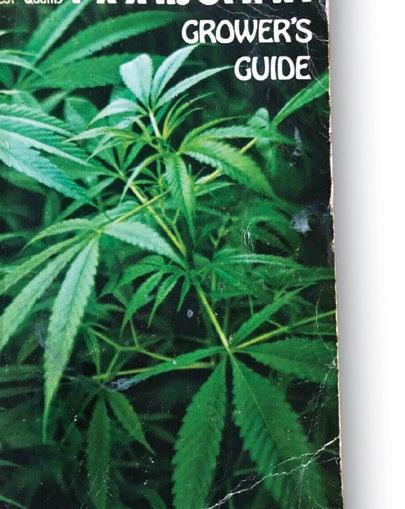
Thankfully, Rosenthal didn’t need HT to establish himself as an expert in Cannabis cultivation.


In 1971, he began building and selling small greenhouses, and in an attempt to get free promotion in their “New York Flyer” supplement, pitched Rolling Stone an article about growing pot. As it happens, another cultivator named Mel Frank had beat him to the punch. After Rolling Stones’ editors arranged a meeting with Frank, Rosenthal suggested that they collaborate on a book. Though reluctant at first, Rosenthal’s persistence eventually persuaded Frank.
As part of their research, they met with Dr. Carlton Turner of the University of Mississippi’s Marijuana Research Project – the only legally-sanctioned Cannabis farm in America. Turner provided them access to recently-published scientific papers on pot, which they then used – along with their own knowledge of horticulture – to produce the first comprehensive textbook on Cannabis cultivation: “The Marijuana Growers’ Guide.”
The first edition of their groundbreaking grow manual was published in 1974, and by 1978 an updated edition of the book was reviewed by the New York Times. Thanks to that review, the book sold over 1 million copies – informing and inspiring a generation of ganja growers, and establishing Frank and Rosenthal as America’s leading authorities on Cannabis cultivation.




HIGH TIMES
That same year, Rosenthal helped organize and judge the first-ever Cannabis Cup in Amsterdam. After Forcade’s suicide in 1978, Rosenthal had been welcomed back into the HT family as a regular contributor. In 1983, he premiered his monthly grow advice column “Ask Ed,” which became the longest-running column in the magazine’s history – that is, until 2000, when it was discontinued due to a legal dispute between Rosenthal and the magazine’s owners.
The trust Forcade had set up to fund the magazine stipulated that in the year 2000, ownership of the magazine would be passed to “loyal employees” who’d been with the company for 10 years or more (Rosenthal claims it was five years, but other accounts say 10). Rosenthal believed he qualified to receive shares in the company, but the trustees disagreed – claiming that he was merely a freelancer, rather than an employee. As a result, he filed a lawsuit against the company to obtain the shares he felt he was owed—a suit which he ultimately lost.
UNITED STATES v. ROSENTHAL Unfortunately, Rosenthal would end up back in court a couple of years later: like many other Cannabis cultivators and activists, he found himself in the crosshairs of the DEA when, on February 12, 2002, federal agents raided his home and nursery in Oakland.


Recognizing that the trial was a farce, Ed employed classic Yippie theatrics by wearing a “wizard of weed” costume into court. These tactics helped draw national media attention and sway public opinion about medical marijuana. Nevertheless, without a viable medical defense, he was convicted in 2003. After the trial, when the jurors learned about the mitigating circumstances, most of them recanted their verdict and begged for his forgiveness.

“They felt terrible,” Rosenthal says. “At my sentencing, 10 of the jurors gave a news conference saying that they were duped by the judge. That was the first time in American history that ever happened, to my knowledge.”
Capitulating to social pressure, Judge Charles Breyer sentenced Rosenthal to just one day in jail, time served. Three years later, after the 9th Circuit Court of Appeals overturned his conviction on a technicality, the U.S. Attorney’s office decided to re-indict him – instigating a second trial in May 2007, presided over by the same judge. Once again, he was prohibited from mounting a medical defense and was convicted.
“I was found guilty again, but I had already done my time, so after the verdict I just walked out. They’d given me a day, and I had done 36 hours, so they still owe me 12 hours,” he jokes.
GIVING BACK
MARIJUANA MUSEUM

In 1985, Rosenthal flew out to Amsterdam to connect with other leading breeders and growers – including Wernard Bruining, Old Ed Holloway, Skunkman Sam and Nevil Schoenmakers. While there, he was contracted by two coffeeshop-owning Dutch brothers to curate the first international Cannabis museum.

“They’d put together this whole museum – it was only missing one thing: the exhibits. They needed somebody who could fill it in three weeks, so I put together a team, worked 16 hours a day, and got it done.”
In 1987, Rosenthal’s friend Ben Dronkers purchased that project, rebranding it as Sensi Seeds’ Hash, Marijuana, and Hemp Museum. (A few years later, Dronkers also bought the Holland Seed Bank from Schoenmakers, who Rosenthal had introduced him to.)




“It was six in the morning, and there was banging at the door. Since I sleep naked, I went down naked to see what was happening … so they knew I was unarmed,” he jokes.
Rosenthal was charged with the cultivation of over 100 plants, but the irony was that the city had legally permitted his garden; in 1999, he’d been appointed an “Officer of the City of Oakland” – deputized to grow those plants for various medical marijuana clubs around the Bay Area. Although it was a nonprofit grow that had the blessing of the city and was legal under Prop 215, his lawyers were prohibited from presenting any of that information to the jury because the case was federal – and therefore state law didn’t apply.
At age 77, Rosenthal is at the peak of his prestige. He’s won numerous lifetime achievement awards and continues to make appearances at Cannabis events around the world. His latest project is the Million Marijuana Seed Giveaway – doling out free seeds of different cultivars he and his friends have bred in an effort to encourage his fans to become pheno hunters. Some of those free seeds are included in the “Prisoners of Weed” book packs for sale on his website, with 10 percent of the proceeds going to the Last Prisoner Project. So far, the packs have raised over $6,000 for pot POWs.
Prepping some seeds to include in one of his Prisoner of Weed book bundles.
“I didn’t have to do time after I was raided … but there are still people out there doing time for a plant many are profiting on now, and that’s wrong,” Rosenthal recently told HT. “We need to change that – yesterday.”
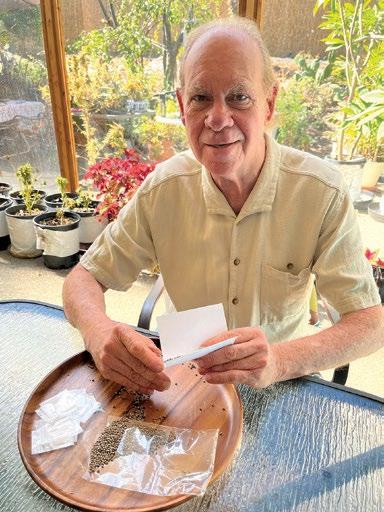


To read the full, unabridged version of this story and listen to the interview on our podcast, visit worldofcannabis.museum/cannthropology.

STORY by BOBBY BLACK @CANNTHROPOLOGY for LEAF NATION
With attorneys in his “wizard of weed” robe outside the courthouse (2007).
PHOTOS
COURTESY OF
ED
ROSENTHAL
HT family as a regular
“The Marijuana Grower’s Guide” informed and inspired a generation of ganja growers, and established Frank and Rosenthal as America’s leading authorities on Cannabis cultivation.
Ed (right) with fellow growers Soma, Wernard Bruining, and Old Ed Holloway in Amsterdam circa 1985.
Ed (right) with fellow growers Soma, Wernard Bruining, and Old Ed Holloway in Amsterdam circa 1985.
THE MOMENT YOUR AUTOMOBILE DOORS are shut with the driveshaft engaged, the contest is underway. Regardless of who is behind the wheel of other vehicles competing for space on the road, your primary objective is to circumvent them to save precious minutes while en route to your destination. And although the unidentified drivers against whom you jockey for position are often good people in your own neighborhood, they have now become faceless adversaries crowding the track.
Like the butts of cigarettes, courtesies are flicked out the window.
And there’s no surprise that this daily race causes tension. Because traffic is a drain on your fragile psyche. And you are not proud of who you become in these moments of frustration when it turns you into a triggered bitch.

You see, we all have a threshold of tolerance that, when crossed, causes a discomforting level of anxiety and stress –fueling the impatience and adding to life’s pressures. And because there is no immediate resolve, you learn to live with the strangulation while building a resentment that weighs on you like an addict’s regret.
You blame the other drivers. “Oh, if only those idiots hadn’t dug themselves into that inescapable cavern of debt like I did.” There’s the mortgage, the auto loan, the kids, the boob job – all the shit you have on autopay that prevents you from turning right out of the driveway instead of left. It’s the right turn that leaves the city toward a tropical paradise … far, far away from the giant magnet that tugs you into the grind.

Fortunately, Cannabis improves your perception. One small toke from a vape pen makes the speakers speak, the seat heaters glow, and the engine vibrate comfort ably for the most optimal enjoyment during your relaxed commute.
You are quite aware that it is against the law to drive stoned.
Thank God for Visine.
38 LEAFMAGAZINES.COM NOV. 2022 stoney baloney FOLLOW @RICKERDJ // GET THE AUDIO VERSION & EVERY EPISODE AT LEAFMAGAZINES.COM




Enjoy dessert with your Danksgiving All binske cannabis-infused chocolate is exclusively made with Peruvian Pure Nacional, which is one of the rarest and most prized cacao crops in the world. License Numbers: CCL20-0000479, CCL20-0000450, CCL20-0000451, CCL20-0000485, CCL20-0000486, CCL20-0000575, CCL20-0000818, C11-0 001216-LIC, CDPH-10004187























 PHOTO by NATE WILLIAMS
@NATEW415
PHOTO by NATE WILLIAMS
@NATEW415









































































































 PHINEST CANNABIS PHINESTCANNABIS.COM
PHINEST CANNABIS PHINESTCANNABIS.COM
 @PHINESTCANNABIS
@PHINESTCANNABIS



































